



The Arts Catalyst in partnership with Furtherfield
Gallery tour with the artists, Saturday 21 June 2pm
The SEFT-1 exploration probe will be on display next to the gallery 20–22 June, 11–13 July, 18–20 July and 25–27 July 2014.
SEE IMAGES FROM THE PRIVATE VIEW
Ivan Puig and Andrés Padilla Domene (Los Ferronautas) built their striking silver road-rail SEFT-1 vehicle to explore the abandoned passenger railways of Mexico and Ecuador, capturing their journeys in videos, photographs and collected objects. In their first London exhibition, SEFT-1 Abandoned Railways Exploration Probe – Modern Ruins 1:220, commissioned by The Arts Catalyst and presented in partnership with Furtherfield in their gallery space in the heart of Finsbury Park, the artists explore how the ideology of progress is imprinted onto historic landscapes and reflect on the two poles of the social experience of technology – use and obsolescence.
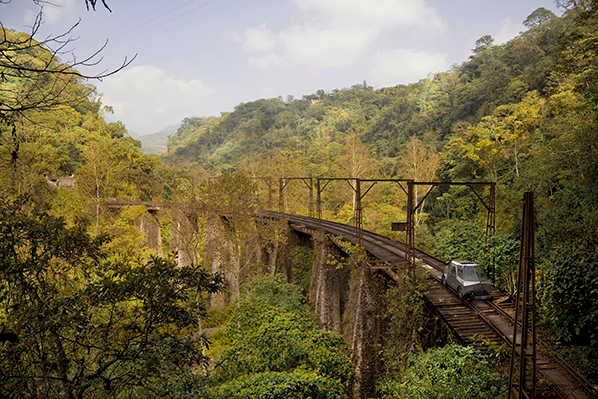
Between 2010 and 2012, the artists travelled across Mexico and Ecuador in the SEFT-1 (Sonda de Exploración Ferroviaria Tripulada or Manned Railway Exploration Probe). In a transdisciplinary art project, they set out to explore disused railways as a starting point for reflection and research, recording stories and testimonials as well as the landscapes and infrastructure around and between cities. Interviewing people they met, often from communities isolated by Mexico’s passenger railway closures, they shared their findings online, www.seft1.com, where audiences could track the probe’s trajectory, view maps and images and listen to interviews.
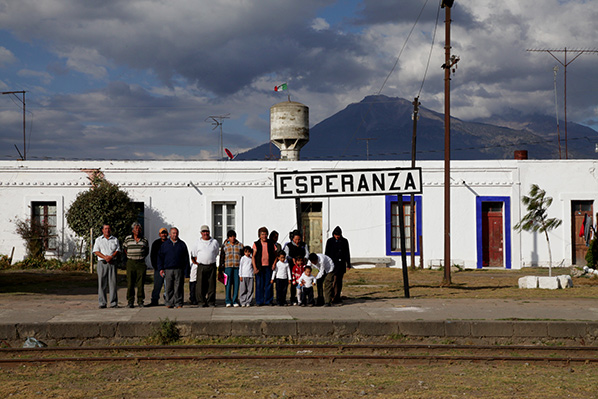
The artists’ journeys led them to the notion of modern ruins: places and systems left behind quite recently, not because they weren’t functional, but for a range of political and economical reasons. In the second half of the 19th century, the Mexican government partnered with British companies to built the railway line that would connect Mexico City with the Atlantic Ocean – and beyond to Europe. This iconic railway infrastructure now lies in ruins, much of it abandoned due to the privatisation of the railway system in 1995, when many passenger trains were withdrawn, lines cut off and communities isolated.
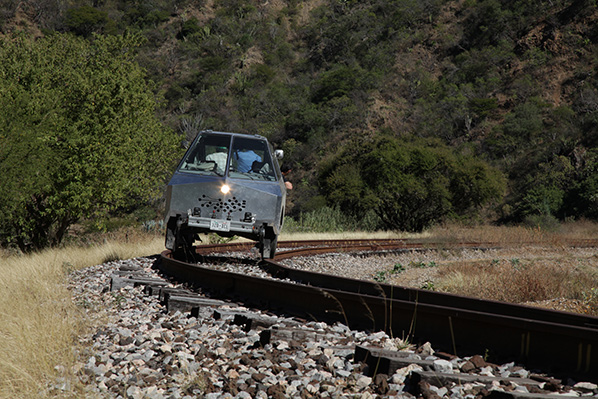
For this new exhibition, the artists are inviting British expert model railway constructors to collaborate by creating scale reproductions of specific Mexican railway ruins exactly as they are now. One gallery becomes a space for the process of model ruin construction. The room’s walls will show the pictures, documents, plans and other materials used as reference for the meticulously elaborated ruin construction. With this action a dystopian time tunnel is created.
Ivan Puig (born 1977, Guadalajara, MX) has exhibited internationally in Mexico, Germany, Canada, Brazil and the United States. He is the recipient of a number of awards and residencies including the BBVA Bancomer Foundation Grant for the SEFT-1 project (2010-2011) and the Cisneros Fontanals Foundation (CIFO) Grant in 2010. Puig, a member of the collective TRiodO (with Marcela Armas and Gilberto Esparza), lives and works in Mexico City.
Andrés Padilla Domene (born 1986 in Guadalajara, MX) has exhibited work in various contexts including ISEA 2012 (Albuquerque, New Mexico), The National Museum of Art MUNAL (Mexico City, 2011), 04 Transitio_MX (Mexico, 2011), and EFRC, Centro de Arte Contemporáneo (Qutio, Ecuador, 2012). His video work as director and producer with Camper Media includes documentaries, fiction films and TV shows.
Tuesday 17 June 6.30–9.00pm – artists Ivan Puig & Andrés Padilla Domene will be in conversation with The Arts Catalyst curator Rob La Frenais during London LASER 04 at University of Westminster (book here)
Saturday 21 June 2pm – Gallery tour with the artists, FREE
Saturday 21 June 3–5pm – A de-industrialised estate – Talk with Dr Malcolm Miles and discussion with the artists at Furtherfield Commons – (limited capacity £5, details and online booking here)
Saturday 12 July 11.30am–1.30pm – Drop in to the gallery and meet model railway maker extraordinaire Neville Reid and artist Andrés Padilla Domene, FREE
Saturday 12 July 2–4pm – Death Collapsing Into Life – Guided walk along Parkland abandoned railway with landscape architect, urbanist and writer Tim Waterman (limited capacity £5 and up to two children under 15 free, details and online booking here)
With support from Embassy of Mexico, Arts Council England, Central de Maquetas.
Furtherfield Gallery
McKenzie Pavilion, Finsbury Park
London N4 2NQ
T: +44 (0)20 8802 2827
E: info@furtherfield.org
Furtherfield Gallery is supported by Haringey Council and Arts Council England
Autonomous spaces, autonomous networks, boxes and forks – we invite all DIY lovers to come and join us for an afternoon of re-appropriation of networking technology to bypass the censorship and liberate our files.
What does a free culture look like? What is technology that supports it? For many years artists (among others) have been engaging with these questions, challenging restrictive laws and regulations as well as complex technical solutions. A new surge in search for practical solutions to file-sharing, easier to use and incorporate to our everyday life is the focus of this workshop. On the day we will install and use Piratebox and Librarybox on various devices to test their promise.
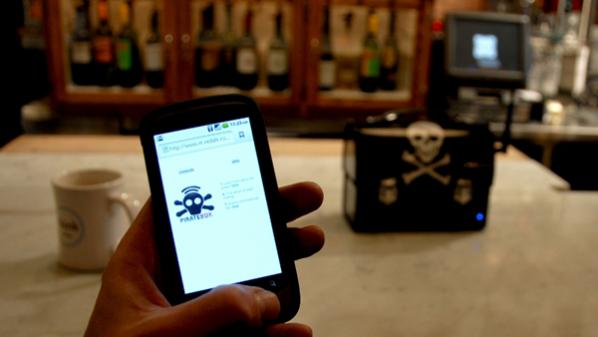
Inspired by pirate radio and the free culture movements, PirateBox utilizes Free, Libre and Open Source software (FLOSS) to create mobile wireless communications and file sharing networks where users can anonymously chat and share images, video, audio, documents, and other digital content.
Piratebox fork, LibraryBox is an open source, portable digital file distribution tool based on inexpensive hardware that enables delivery of educational, healthcare, and other vital information to individuals off the grid.
+ For more information about the event please contact Larisa Blazic.
Flossie is for women interested in using open source as coders, artists and social innovators. We run an annual conference and also regular events in London.
Furtherfield Commons
Finsbury Park
Near Finsbury Gate On Seven Sisters Road
E: info@furtherfield.org
Furtherfield Gallery is supported by Haringey Council and Arts Council England.
Codasign, in partnership with Furtherfield, will be running a new series of creative technology workshops for different ages at Furtherfield Commons, a hub to connect and activate local and international communities of artists, technologists, thinkers and doers.
Interactive Puppet and Story Workshop
Saturday 15 February 2014
10am – 12:30pm – 6-9 year olds
2-4:30pm – 9-12 year olds
Come and learn how to create your very own interactive hand puppet which tells you a story using Scratch and MaKey MaKey!
Create a Tron Hoodie
Sunday 23 February 2014
11am – 1pm
Upcycle your hoodie using electroluminescent wire.
Make Your Own Platform Game With Scratch
Saturday 1 March 2014
10am – 12pm – 6-9 year olds
1:30-4pm – 9-12 year olds
Learn how to create your very own platform based computer game in Scratch!
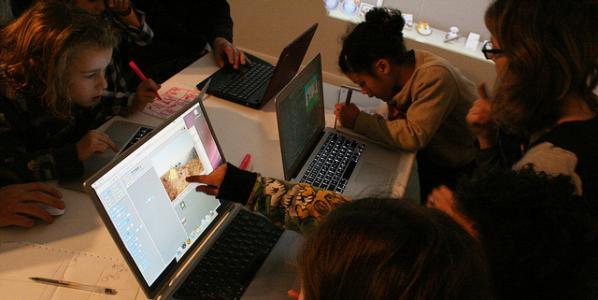
Miniature Circuit House
Saturday 15 March 2014
10am – 12pm – 6-9 year olds
1:30 – 3:30pm – 9-12 year olds
Wire up your own shoebox sized house using different electronic components which will be inserted into a circuit drawn with Bare Conductive‘s paint.
Soft circuit phone badge
Saturday 22 March 2014
10am – 1pm
Create a soft circuit badge which flashes when your phone receives a text message or is ringing.
Make a Musical Instrument with Paint, Scratch and MaKey MaKey
Saturday 24 May 2014
10am – 12pm – 6-9 year olds
1:30 – 4pm – 9-12 year olds
Come and learn how to make a conductive painting to control a musical instrument that you’ve created in Scratch and MaKey MaKey!
For more information and to book a place to any of the workshops please visit Codasign website.
All supporting material for the workshop will be available at learning.codasign.com.
VISITING INFO
Located by Finsbury Gate entrance on Seven Sisters Road
T: 0208 802 1301
E: info@furtherfield.org
On 29 March it’s going to be Arduino Day 2014!
Furtherfield and Codasign will be hosting a day full of free activities at Furtherfield Commons in Finsbury Park. We would like to invite anyone interested in physical computing – people from all ages and all levels of expertise – to come and spend the day with us.
The day will consist of a series of FREE Arduino taster workshops for absolute beginners in the morning and a showcase of interesting interactive Arduino projects by artists, techies and enthusiasts in the afternoon. To participate in the workshops or to show your work, please see details below.
WORKSHOPS
10:00 – 11:00 Intro workshop for children (9-12 years old)
11:30 – 12:30 Intro workshop for young people (13-18 years old)
13:00 – 14:00 Intro workshop for adults
14.30 – 17:00 SHOWCASE
The workshops with give you a taster of how to work with Arduino, teaching you how to write your very first ‘sketch’ as well as how to build circuits on breadboards. We will work with components such as LEDs, potentiometers, Piezos and more! For the kids workshop we’ll combine Arduino with Scratch to show children how these two platforms can communicate with each other. For the workshops for young people and adults we will purely be using the Arduino environment, but will also be demonstrating how you can use it on your Raspberry Pi! All workshops are FREE. For more details about the workshops and how to sign up, please visit the Codasign webpage.
If you have an Arduino project you would like to show and discuss, we would like to invite you to participate in our Arduino Showcase. This is an opportunity to share your work and hear about what others are doing, to meet people, to be inspired, and, mainly, to have a good time. If this sounds like something you would like to do, please fill in this form. We aim for this to be a friendly and informal event, where visitors can wander around, get ideas, ask questions and play with the projects being showcased. We will provide power, Internet, and a table, and of course, there will be drinks.
If you have any questions or would like to discuss any details with us, please get in touch with Olga, olga@furtherfield.org.
Furtherfield Commons
Finsbury Park
Near Finsbury Gate On Seven Sisters Road
E: info@furtherfield.org
Furtherfield Gallery is supported by Haringey Council and Arts Council England.
‘RE / PRE / SENT / PAST’, an exhibition featuring works by media artist Markus Soukup as part of Furtherfield Clear Spots programme, explores different phenomena from dreamscapes to long distance travel recordings, as well as attempted considerations of societal change in relation to technological developments.
It brings together fragments of subjective experiences related to contemporary everyday existence, which were translated and transformed into ‘perceivable outputs’ by using different digital techniques. The screen or the physical object as output constitutes an interface, where perceptual experiences of the spectator intermix with the intentions of expression.
The wonders of perception are connected to imagination processes and a continuous stream of individual interpretation that play with the question of what defines objective reality.
Markus Soukup is a media, video and sound artist living and working in London since 2012.
In general he considers the process of making work as an exploration of how an object, image or moving image can communicate its intended content or expression by still enabling freedom of interpretation on realistic and abstract levels.
He is fascinated by the infinity of possibilities and starting points, which the work with moving images provides. Since the end of the 90s he produces videos, 2D and 3D animations investigating the narrative, expressive, poetic and aesthetic potentials of this time-based medium.
A series to be continued investigates language and its structure by de-constructing content or flow, breaking it into parts and reconstructing it on a time based level. Other areas of his work incorporate digital photography and typography, graphic and interactive design, field recordings and electronic music.
His work has been shown in local, national and international exhibitions and festivals, for instance at the 11th international Media Art Biennale WRO 05 (Wroclaw, Poland, 2005), NEXT UP at the Bluecoat Liverpool (2008), the 10th Seoul International New Media Festival (Republic of Korea, 2010) and the Liverpool Biennial 2010.
In 2011 he was awarded the Liverpool Art Prize. As a result his work was shown in the ‘Elements & Satellites’ exhibition at the Walker Art Gallery, part of National Museums Liverpool in 2012.
In 2013 he was commissioned by Metal Culture to produce the video installation Strata for the ‘STILL, conflict, conservation & contemplation’ exhibition curated by Simon Poulter at City Gallery Peterborough.
Recent exhibitions include Infinite Separation, part of ‘Art:Language:Location’ at Anglia Ruskin Gallery Cambridge, and Disjointed at Museum Ex Teresa Arte Actual in Mexico City.
+ More information:
www.toofastproductions.co.uk
Furtherfield Gallery
McKenzie Pavilion, Finsbury Park
London N4 2NQ
T: +44 (0)20 8802 2827
E: info@furtherfield.org
Furtherfield Gallery is supported by Haringey Council and Arts Council England.
Exhibition Tour and Artists Talk (Magnus Eriksson and Geraldine Juárez)
Saturday 03 May 2014, 2pm
Exhibition tour led by Magnus Eriksson and Geraldine Juárez followed by a live walk-through of the Piratbyrån archive and talk about some overlooked gems from their history at Furtherfield Commons. Expect to learn some Swedish while we are at it!
SEE IMAGES FROM THE PRIVATE VIEW
Contact: info@furtherfield.org
Curated by Rachel Falconer & Furtherfield
EXHIBITION TRAILER – Piracy as Friendship
@Furtherfield “Don’t contact future. Future will contact you!”
“For the last sixty years, capitalism has been running a pretty tight ship in the West. But in increasing numbers, pirates are hacking into the hull and the holes are starting to appear. Privately owned property, ideas, and privileges are leaking into the public domain beyond anyone’s control.” – Matt Mason, The Pirate’s Dilemma
Piratbyrån and Friends traces the stories of cultural sharing and affinity-building among the activities and values of the members of Piratbyrån (The Bureau of Piracy). This Swedish artist/activist group was established in 2003 to promote the free sharing of information, culture and intellectual property. The exhibition presents screenings, installations and artworks by founding and more recent members, keen to tell the story of the group on their own terms. It features newly commissioned work by artists Geraldine Juarez and Evan Roth, and a new networked audio collaboration which mediates their rich archive and foregrounds the role of piracy as an agent of innovative disruption and cultural transmission.

“The specific character of friendship as a form of social relationship is that it does not presume a permanent interaction. Friendships are a type of serial solidarity. The story of friendship is a story of meetings.” Viktor Misiano – The Institutionalization of Friendship.
Piratbyrån have always resisted clear definition. Created on the Internet as a loose friendship group with a shared commitment to media and piracy in the shifting ecologies of digital copyright law, Piratbyrån operated through a number of different identities. From the #discobeddienti IRC chatroom, to the infamous Pirate Bay, to the determinedly analogue SX23 bus trip to Manifesta 7, and their subsequent disbandment in 2010, Piratbyrån consciously cultivated an air of mystery and intrigue around their many activities.
Piratbyrån have always had a particular commitment to the value of friendship as a shelter for culture and a space to understand, imagine and experiment as a community from the edges of the Internet.
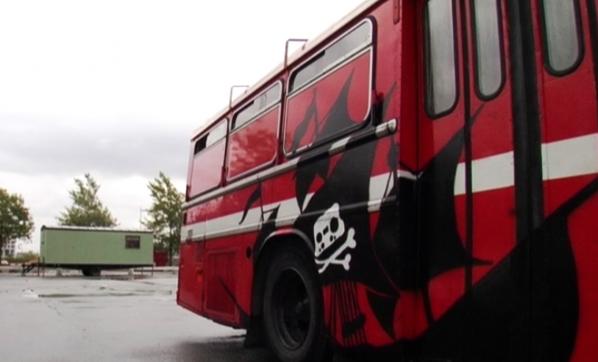
The exhibition features newly commissioned sculptures and installations by artists James Cauty, Geraldine Juárez and Evan Roth and a screening programme that includes Steal This Film by Jamie King and Piratbyrån and Friends by Geraldine Juarez.
Tapecasts (2013-2014) – Piratbyrån and Friends
SK23 Suit (2008) – Lina Persdotter Carlsson / Piratbyrån
S23m Manifesta Bus Trip (2008) – Piratbyrån & Simon Klose
S23x Belgrade Bus trip (2008) – Piratbyrån
Polymarchs posters (1980-1990) – Jaime Ruelas
Sharing is Caring Map (2008) – Sara Wolfert / Mathias Tervo / Piratbyrån
Kopimi Totem (2014) – Evan Roth
Torrent Tent (2014) – Geraldine Juárez
Riot Chat (2014) – Palle Thorsson
Smiley Riot Shield 2 (Second Edition) and PB2 (2014) – James Cauty
Piratbyrån (The Bureau for Piracy) was started by a bunch of hacking, coding, reading, listening, philosophising, clubbing, rioting, carding, chatting, loving, slacking people in 2003 as an antidote to Hollywood’s representatives in Sweden – Antipiratbyrån.
In 2007 – after having kickstarted the Swedish debate over file-sharing, which by the time had become a major issue in the previous years national election and after having created The Pirate Bay as a side-project that became the world largest file-sharing system – the people from Piratbyrån had grown tired of the file-sharing debate and its endless repetitions of for-or-against, legal-or-illegal, payment-or-gratis. At the last day of April in a Walpurgis fire on the top of the highest mountain in Stockholm the masked members burned the remaining copies of a book on file-sharing they had published some years earlier and declared the debate dead. The video documentation of this ritual, set to the soundtrack of KLF’s “What Time is Love”, found its way to the Indian Raqs Media Collective group who was just about to curate the next Manifesta biennial in Bolzano, Italy.
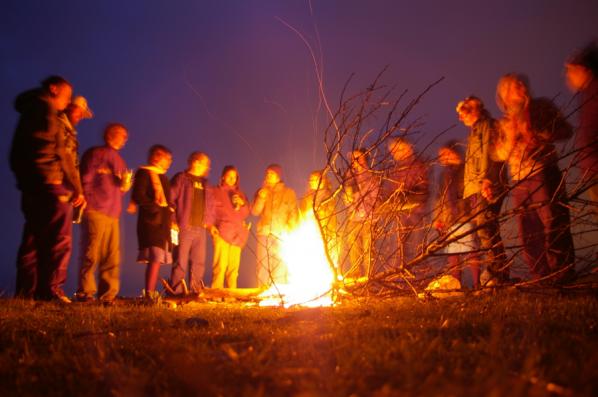
The loose network of Piratbyrån, now loaded with 7000 Euros of art budget and a sizable amount of cash from selling Pirate Bay t-shirts, decided to purchase, renovate and decorate a 1970s city bus, stack it with 23 people, and head down south.
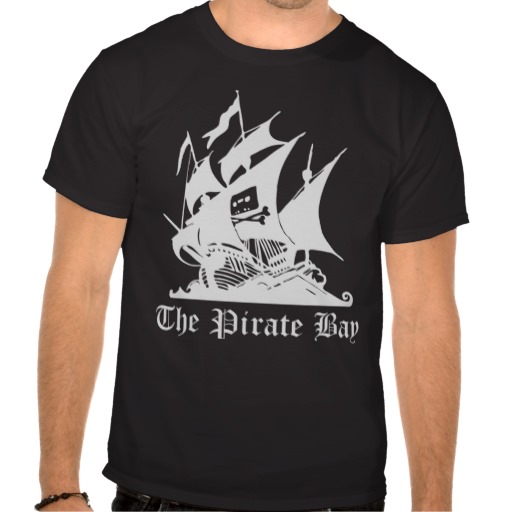
The ongoing relation with the bus – named S23m/x/k respectively for each trip – would later make an exodus from the exhibition in Italy to head across Eastern Europe and end up at the trial against Pirate Bay. It became one of the most significant undertakings of Piratbyrån and shaped their thoughts on the tensions between digital abundance and crowded space, collective decisions and freedom of choice, and that which can be copied and that which can’t. The bus became a line of flight from the collective subject that had been built, a subject which was very associated with The Pirate Bay and also with Swedish politics, including the Pirate Party.
While nothing was really the same after the bus had returned, Piratbyrån formally lasted until 2009, when the tragic death of one of the founding members – Ibi Kopimi Botani – defined the end of an era. The Internet had already transitioned to another phase and it is not until now, and enough time has passed, that we as a culture are ready to reflect on what exactly happened during those years.
Piratbyrån always had an implicit friendship with the KLF. They share the same historical web of connections and share a similar trajectory, but their activities are shifted in time by roughly a decade. The only contact between the two is a response from Bill Drummond when Piratbyrån sent a link to the documentation of the Walpurgis ritual. It read:
> Thank you for your email.
> I have just read the text at the link.
> I enjoyed it and understood it.
It is probably good that they didn’t exist at the same time because the gap in time gives the relation an infinite unresolvable tension of unfulfilled connectivity and unlimited possibilities.
James Cauty
For Piratbyrån, James Cauty’s personal work resonates with the themes of abundance and rarity, presence and absence, functionality and waste, control and chaos, and draws on the same symbolic language that mixes clarity with suggestion. There is also a similar urge to *stir things up* and *stick ones nose where it doesn’t belong*.
Evan Roth
Speaking of stirring things up, FATLAB was for Piratbyrån another one of those instantly recognisable friends that had never met; the art group that Piratbyrån never became, the “the unsolicited viral marketing wing of the open-source movement”, the graffiti crew of the World Wide Web. FATLAB was born when the file-sharing debate was buried and the new web 2.0 era transformed the web.
Evan Roth, co-founder of FATLAB, has made a piece for the exhibition that in a subtle but direct way captures the concept of KOPIMI; how meetings and connections leave traces and makes you a carrier of ideas and information, sometimes without you even recognising it.
Jaime Ruelas & Polymarchs
The soundsystem collective Polymarchs and their illustrator Jaime Ruelas, probably happily unaware of the existence of Piratbyrån, embodies a scene in Mexico where piracy has always been a way of life and a mode of existence. They have materialised, expressed and lived what was only hinted at in glowing screens up in Sweden. Having outlasted all of the above mentioned collectives and managed to stick together for decades, they also highlight both the potential strength and – as a contrast – the fragility of so called “confidential projects”; those moments when friendships turn into expressive units and the borders between the intimate and the public are blurred.
Geraldine Juárez
Last but not least, Geraldine Juárez is the reason this exhibition came together at all. She began to read the Swedish-language blogs of Piratbyrån members through Google translate – whose mistranslations made them sound like they came from the near future instead of the near past, until she finally came into contact with Piratbyrån by translating updates from the trial – or Spectrial, as it was known – into Spanish. Now she returns the favor of time-travelling by re-awakening Piratbyrån one last time, to allow their archive to again live up, their ideas to be carried over to others and perhaps even some sense made from what happened, although these things can only be interpreted, misunderstood and re-appropriated – never explained.
Inside the tent that she has crafted for the exhibition – a torrent for piracy as the last shelter of culture – there will be a collection of tapes prepared and circulated by Piratbyrån and friends, perhaps giving some seed for thoughts and guidance in the process of excavating the archive of Piratbyrån.
About co-curator Rachel Falconer
Rachel Falconer is a curator, writer and producer working at the intersections of technology, the media and contemporary art. She currently holds the position of Head of Art and Technology at SPACE and runs the art and technology programme at The White Building and SPACE MediaLab. She is Co-Editor at Furtherfield and a founding member of the collective Hardcore Software.
Her curatorial practice is hybrid and interdisciplinary in approach and her current activity and research focuses on the pathologies surrounding social spaces and human behaviours engaged with networks and new technologies.
Furtherfield Gallery
McKenzie Pavilion, Finsbury Park
London N4 2NQ
T: +44 (0)20 8802 2827
E: info@furtherfield.org
Furtherfield Gallery is supported by Haringey Council and Arts Council England
Contact: info@furtherfield.org
Furtherfield Gallery is pleased to host One Minute Volume 7, a new series of shorts curated by filmmaker Kerry Baldry. The screening is accompanied by One Minute Remix, a selection of moving images from One Minute Volumes 1-5.
One Minute Volume 7 is the latest in the edition of One Minute artists’ moving image programmes curated by artist and filmmaker Kerry Baldry, and includes an eclectic mix of artists’ moving image constrained to the time limit of one minute. The One Minute programmes have been screened at numerous galleries, artists spaces and film festivals worldwide.
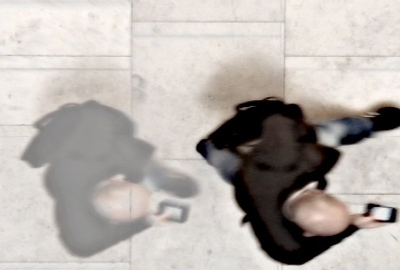
Volume 7 includes work by John Smith, Rose Butler, Tony Hill, Steven Ball, Alexander Costello, Leister/Harris, Kayla Parker and Stuart Moore, Louisa Minkin, Claire Hope, Max Hattler, Guy Sherwin, Steven Woloshen, Lynn Loo, Lumière and Son, Tansy Spinks, Gary Peploe and Peter Nutley, Eva Rudlinger, Michael Szpakowski, Zhel (Zeljko Vukicevic) , Matthias Kispert, Stuart Pound, Sellotape Cinema, Alex Pearl, My Name Is Scot, Kerry Baldry, Esther Johnson, Marty St. James, Nicki Rolls, Katherine Meynell, Chris Paul Daniels, Riccardo Iacono, Edwin Rostron, Martin Pickles, Grant Petrey, Annabel Dover, Kelvin Brown.
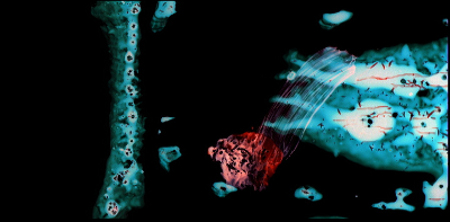
One Minute Remix (a selection from One Minute volumes 1 – 5) was originally compiled by Kerry Baldry for a screening as part of Kayla Parker and Stuart Moore’s moving image event ‘Welcome to The Treasure Dome’ (in a ICCI 360 Arena, which displayed audiovisual/moving image artwork via 5 projectors, with the screens arranged in a ‘seamless’ circle wrapped around the inside of a 21-metre diameter dome, and with surround sound) on behalf of ICCI (Innovation for the Creative and Cultural Industries) with Plymouth University; part of Maritime Mix – London 2012 Cultural Olympiad by the Sea programme, Weymouth (10 and 11 August 2012).

The programme includes work by Martin Pickles, Alex Pearl, Steven Ball, Gordon Dawson, Michael Szpakowski, Virginia Hilyard, Barry Lewis, Nick Jordan, Claire Morales, Nicki Rolls, Kerry Baldry, Riccardo Iacono, Eva Rudlinger, Zhel (Zeljko Vukicevic), Esther Johnson, Sam Renseiw and Philip Sanderson’s Lumière & Son, Katharine Meynell, Stuart Pound, Kayla Parker and Stuart Moore, Ron Diorio, Daniela Butsch, Guy Sherwin, Louisa Minkin, Rose Butler, Dave Griffiths.
+ More information: http://oneminuteartistfilms.blogspot.co.uk/
Produced by Furtherfield.
Kerry BaldryKerry Baldry is an artist/filmmaker who works in a range of media including film and video. She is a Fine Art Graduate from Middlesex University who went on to study film and video at Central St. Martins. Her first commissioned film was to make a film for BBC2’s One Minute Television which was broadcast on The Late Show – a joint collaboration between BBC2 and Arts Council England.
Over the last 6 years, aside from producing her own work, she has been curating, promoting and distributing a self initiated, unfunded project titled One Minute, One Minute Volume 7 being the latest in the edition. One Minute Volumes 1-7 are an eclectic mix of artists moving image constrained to the time limit of one minute and includes over 80 artists at varying stages of their careers.
Furtherfield Gallery
McKenzie Pavilion, Finsbury Park
London N4 2NQ
T: +44 (0)20 8802 2827
E: info@furtherfield.org
Furtherfield Gallery is supported by Haringey Council and Arts Council England.
Contact: info@furtherfield.org
Visiting Information
Imagine visiting Finsbury Park in the not too distant future…
You could explore the sensory and medicinal properties of different plants in the Discovery Meadows; Play Glades offering people of all ages a range of adventurous physical challenges within a variety of wooded areas; visitors could go on a cultural tour of ‘natural rooms’ in the park, accessed through mobile devices; community gardens used for a wide range of events supporting and encouraging local people to come together around pleasurable growing, foraging and cooking events; Memorial Gardens providing an inspiring and elegant space for people of all faiths to take a moment to remember their passed loved ones.
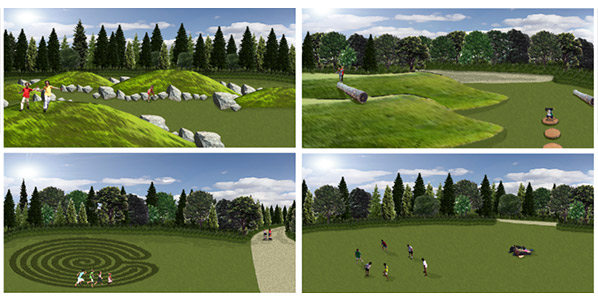
These are just some of the futuristic ideas that students from the Writtle School of Design (WSD) will be exhibiting at Furtherfield that imagine possible futures for Finsbury Park.
In early 2013 WSD students created plans for the whole park, and then a number of individual designs for key spaces within the Park. They were asked to look at ways that Finsbury Park and Furtherfield could both provide more pleasing spaces and encounters for the surrounding communities. The opening of Furtherfield Commons, a new pop-up art, technology, and community space located within the park at the Finsbury Park Station entrance, will also be celebrated. Furtherfield Commons will serve as the venue for presentations from Furtherfield and Writtle School of Design students and staff about their visions for the park alongside an exhibition of the full array of inspirational images and ideas, and video interviews with the designers. Visitors are invited to make comments.
Press view and VIP private view: Friday 22 November, 2-5pm
Open 12-4pm Saturday and Sunday for two weekends. 23, 24, 30 November and 1 December 2013
Local people are encouraged to come along and respond to the designs.
Furtherfield Commons
Finsbury Park
Near Finsbury Gate On Seven Sisters Road
E: info@furtherfield.org
Furtherfield Gallery is supported by Haringey Council and Arts Council England.
Old Words Made New.
Ethical knowledge, sacred spaces, forgotten histories and challenging predispositions.
Furtherfield is pleased to present the excellent cross cultural project DISCLOSURE: Old Words Made New. We have collaborated with Medieval Studies Graduate Students from King’s College London, and artist Erica Scourti to reversion a contemporary representation on the subject of medieval social lives, based on the theme of ‘ethical knowledge’ through Old English. With a combination of works in the Finsbury Park surroundings, sound installations, collaborative writing, and performance.
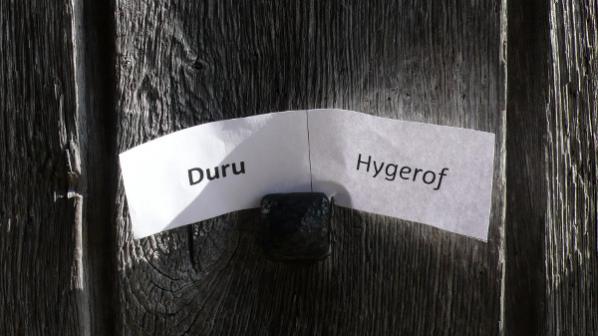
The project is part of Colm Cille’s Spiral project, a collaboration between Difference Exchange, King’s College London and Furtherfield, and takes place alongside a commission by artist Erica Scourti. It relates to a series of contemporary art and literature commissions and dialogues rethinking the legacy of 6th Century Irish monk Colm Cille, or St Columba, that unfolds across Ireland and the UK, starting and ending in Derry-Londonderry for City of Culture 2013.
Come and add an Old English phrase to the Wordhoard painted onto the walls of Furtherfield Gallery!
Help us create a visual hoard of words, received from scholars all over the world, which will show the extent of the current study of Old English. Explore the memories of our site-specific work at Bradwell-on-Sea, a church built in 654 by St Cedd, by watching our recording of the event. Walk through Finsbury Park listening to the sounds of Old English poetry and meditating on trees that bleed.
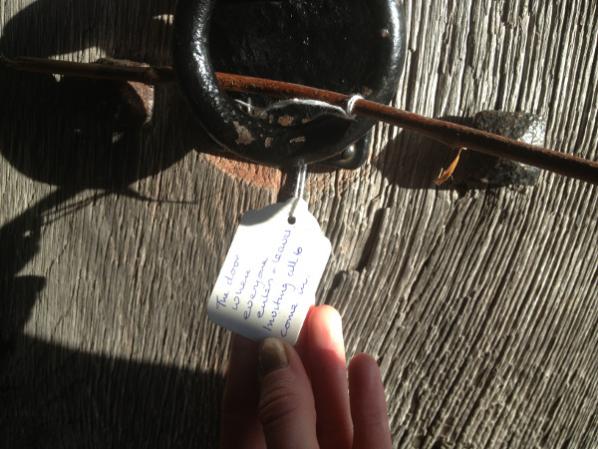
For the event, Erica Scourti will present another iteration of her video postcard project, currently existing as a series of empty, annotated videos on her Instagram profile. As a one-off, the full set of over 100 videos emailed out to friends, family and online contacts over the summer period will be screened, the only time they will be shown publicly. Also, the metadata the recipients provided for each video will form the basis of a sound piece that will play throughout the afternoon.
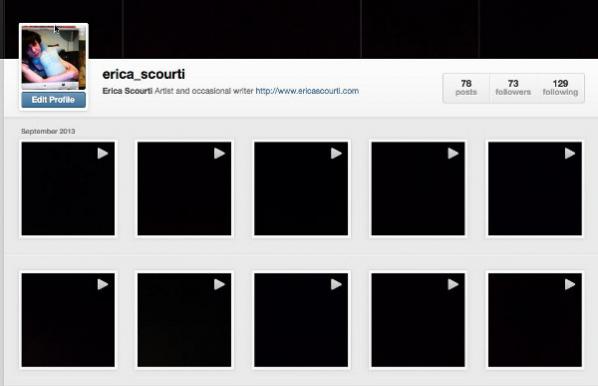
The project has explored new ways to understand and interpret the language and social contexts of a time where Christianity was at its early phase of using its people through networks around the UK, whilst pagan culture was still thriving.
The question posed to the King’s College students was “If we existed in a contemporary society where the Internet could no longer be trusted because of systems of networked surveillance, what would be the different ways in which we could communicate?”
In July 2013 they showcased their findings at a live public event at the historic Bradwell-on-Sea Church, which is now being held at Furtherfield.
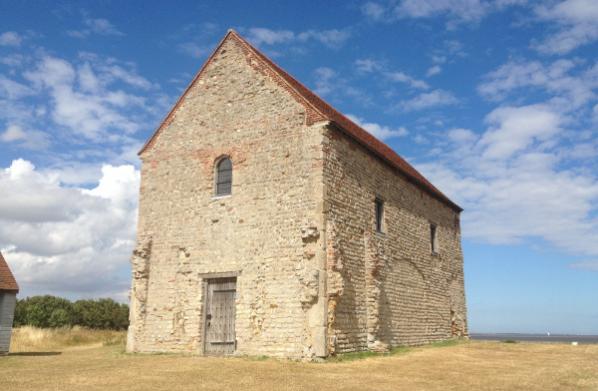
A warm thanks to Kings College lecturers Professor Clare Lees, Dr Joshua Davies, Dr James Paz for collaborating.
Other Colm Cille’s Spiral projects have taken place across the UK and Ireland as part of Derry-Londonderry City of Culture and can be explored at www.colmcillespiral.net
Furtherfield Gallery
McKenzie Pavilion, Finsbury Park
London N4 2NQ
T: +44 (0)20 8802 2827
E: info@furtherfield.org
Furtherfield Gallery is supported by Haringey Council and Arts Council England.
Public Screening and Discussion at Furtherfield
Contact: info@furtherfield.org
Visiting Information
THE EVENT HAS LIMITED AVAILABILITY.
PLEASE RSVP TO BOOK YOUR PLACE TO ALESSANDRA
Cornelia Sollfrank will present her latest film Giving What You Don’t Have. It features interviews with individuals Kenneth Goldsmith, Marcell Mars, Sean Dockray, Dmitry Kleiner, discussing with Sollfrank their projects and ideas on peer-to-peer production and distribution as art practice. It includes the projects ubu.com or aaaaarg.org, which combine social, technical and aesthetic innovation; they promote open access to information and knowledge and make creative contributions to the advancement and the reinvention of the idea of the commons.
The post-screening discussion will be led by Cornelia Sollfrank, Joss Hands & Rachel Baker.
On the basis of the interviews of Giving What You Don’t Have, we would like to discuss some of the issues they represent such as new forms of collaborative production, the shift of production from artefacts to the provision of open tools and infrastructures, the development of formats for self-organisation in education and knowledge transfer, (the potential and the limits of) open content licensing as well as the creation of independent ways of distributing cultural goods. An implicit part of Giving What You Don’t Have is a suggested reconceptualization of art under networked conditions.
Cornelia Sollfrank is a postmedia conceptual artist and interdisciplinary researcher and writer. She studied painting at the Academy of Fine Arts in Munich and fine art at the University of Fine Arts of Hamburg (1987-1994). Since 1998 she has taught at various universities and written on issues in the nexus between media, art and politics. In 2011 Sollfrank completed her practice-led interdisciplinary research at Dundee University (UK) and published her PhD thesis with the title Performing the Paradoxes of Intellectual Property. In addition to her work in the artistic and academic fields, Sollfrank gathered experience in the private sector by working as product manager for Philips Media for two years (1995-1996).
Joss Hands‘ research engages the relationship between media, culture and politics. His recent work has explored the role of digital media in direct action, protest and activism, culminating in his book @ is For Activism: Dissent Resistance and Rebellion in a Digital Culture, published by Pluto Press in 2011. His previous research has explored the role of new media in formal democracy and governance as well as its cultural, economic and social impact. He has published in a number of journals such as Information, Communication and Society, Philosophy and Social Criticism and First Monday as well as writing commentary for publications such as Open Democracy, IPPR Journal, The New Left Project, and others.
Rachel Baker is a network artist who collaborated on the influential irational.org. Her art practice explores techniques used in contemporary marketing to gather and distribute data for the purposes of manipulation and propaganda. Networks of all kinds are “sites” for Baker’s public and private distributed art practice, including radio combined with Internet (Net.radio), mobile phones and SMS messaging, and rail networks. She has presented and exhibited work internationally at various new media and electronic art festivals.
Giving What You Don’t Have is an artistic research project commissioned by the Post-Media Lab, Leuphana University.
Furtherfield Gallery
McKenzie Pavilion, Finsbury Park
London N4 2NQ
T: +44 (0)20 8802 2827
E: info@furtherfield.org
Furtherfield Gallery is supported by Haringey Council and Arts Council England.
LIVE LINK HERE
In collaboration with Annie Abrahams and Emmanuel Guez, Furtherfield presents two new ReadingClub sessions based on excerpts from McKenzie Wark’s A Hacker Manifesto [version 4.0] and the ARPANET dialogues.
ReadingClub proposes a text and an interpretive arena to 4 readers. These readers write together their reading of a text inside the text itself. The audience sees an evolving, cinematographic picture of thoughts and collaborative writing in the making.
Join the performance online at readingclub.fr and use the chat window to exchange, discuss and comment on the performance.
Monday 21 October 2013, 8pm London Time – A Hacker Manifesto [version 4.0]
Online performance session based on an excerpt from A Hacker Manifesto [version 4.0] by McKenzie Wark – with Aileen Derieg, Cornelia Sollfrank, Dmytri Kleiner and Marc Garrett.
Drawing in equal measure on Guy Debord and Gilles Deleuze, A Hacker Manifesto offers a systematic restatement of Marxist thought for the age of cyberspace and globalization. In the widespread revolt against commodified information, McKenzie Wark sees a utopian promise, beyond the property form, and a new progressive class, the hacker class, who voice a shared interest in a new information commons.
Tuesday 22 October 2013, 8pm London Time – The ARPANET dialogues
Online performance session based on an excerpt of the ARPANET dialogues from 1975-1976 – with Alessandro Ludovico, Jennifer Chan, Lanfranco Aceti and Ruth Catlow.
The ARPANET dialogues is an archive of rare conversations within the contemporary social, political and cultural milieu convened between 1975 and 1979 that were conducted via an instant messaging application networked by computers plugged into ARPANET, the United States Department of Defense’s experimental computer network. All participants in the conversation were given special access to terminals connected to ARPANET, many of them located in US military installations or DOD-sponsored research institutions around the world.
What was originally thought to be a historic moment, when figures from within and without the established art canon first encountered the disruptive effects of digital network communications, turned out to be an ongoing research project by Bassam El Baroni, Jeremy Beaudry and Nav Haq.
Further reading:
“This pre-Internet chatroom conversation between Jim Henson, Ayn Rand, Yoko Ono and Sidney Nolan is fake. But it’s amazing” – Robert Gonzalez in io9, December 2012.
“Ronald Reagan has joined the chatroom” – Interview by Richard Fischer, CultureLab with Jeremy Beaudry, one of the artists behind the project, April 2011.
The ReadingClub is a project by Annie Abrahams and Emmanuel Guez, inspired by Brad Troemel’s Reading Group and the Department of Reading by Sönke Hallman.
The project is supported by Dicréam.
+ More information about ReadingClub
In conjunction with Shu Lea Cheang and Mark Amerika exhibition, Furtherfield is pleased to host Shu Lea Cheang’s Seeds Underground Party.
In certain parts of the world, the vast farmlands have been colonised by genetically modified crops for our staple foods (i.e. wheat, soybeans, corns). Introduced 30 years ago, the transgenic biotechnology has since been commercialised by the patent-protected corporate sectors. Taking over the wholesale markets, the Herbicide-tolerant and pest-resistant seeds promise higher yields and profits without much ecological concerns. This year, the European Union is about to adopt a new seed policy, which favours the seed industry corporations by making all seeds subject to strict regulation. It is feared that this will hurt organic varieties and prevent seed exchange by seed farmers and savers.
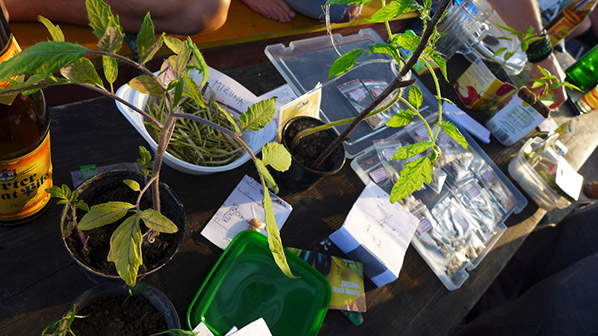
Join us for a seed exchange party where packets of seeds change hands and go underground in the fields around Finsbury Park and beyond.
Bring your self-harvested homegrown seeds of sorts! Sign on to trade seeds, to adopt and germinate, to broadcast and track their distribution. Share some food, drinks and seeds stories while we celebrate the harvest season together in the relaxing setting of Finsbury Park.
+ To join Seeds Underground Party, and trade and track your seeds, please register on http://seedsunderground.net
Click on TRADE and select Furtherfield, London from the “join a seeds underground party” pull down menu.
Seeds Underground holds seed exchange parties where packets of seeds change hands and go underground in the fields across nation borders.
+ More information:
now@seedsunderground.net
www.seedsunderground.net
Furtherfield Gallery
McKenzie Pavilion, Finsbury Park
London N4 2NQ
T: +44 (0)20 8802 2827
E: info@furtherfield.org
Furtherfield Gallery is supported by Haringey Council and Arts Council England
On second day of summer, Maja Kalogera & Med-i-kids from AKC Medika in Zagreb, will gather in Finsbury Park in front of Furtherfiled Gallery. They will present Classical Sitting Squatters. They are quite a joyful bunch, they recite, chirp, sing, blink, sit still, just name it. You are invited to join them/us for a drink and meet them in ‘person’, on Saturday 22 June 2013, between 11am and 5pm.
Classical Sitting Squatters (CSS) is an installation made of a dozen full-sized figures or ‘sitting’ sculptures. They are reciting poetry of Gertrude Stein, Dylan Thomas and Emily Dickinson, on the input of the passers-by.

Med-i-kids is an open group of street artists which connected in Medika, Zagreb. Their mission is to make public artworks to raise awareness and question the many dogmas present in Croatian society, the very same society positoned in third place as one the most courrupted countries positioned.
Maja Kalogera is an artist, curator and catalyst who consistently places herself at the convergence of art and technology. Born in Zagreb, she holds B.F.A. from School of Applied and Visual arts, Zagreb and M.Arch. from Architecture University, Zagreb. From 1999 she is member of the online collective wowm.org. Her creative work over the past 15 years has included a wide range of mediums: digital and interactive media, photography, painting, video and film. In 2005, she founded Center for synergy of digital and visual arts, a Zagreb based NGO, that provides her unique approach focused on synergy between traditional art media with new, digital media. In her own artwork she is interested in ways how people participate in physical and virtual spaces. Lately she started to collaborate with med-i-kids on socially engaged projects.
Opening Event: Seeds Underground Party – Sat 31 August, 2-5pm
Contact: info@furtherfield.org
Visiting Information
ABOUT THE EXHIBITION
ABOUT THE ARTWORKS
ABOUT THE ARTISTS
EVENT: SEEDS UNDERGROUND PARTY
TALK: SHU LEA CHEANG – ART, QUEER TECHNOLOGIES AND SOCIAL INTERFERENCE
LOCATION
SEE IMAGES FROM THE PRIVATE VIEW
WATCH VIDEO OF THE OPENING
This exhibition by Mark Amerika (US) and Shu Lea Cheang (US/FR) at Furtherfield Gallery marks a significant moment for contemporary art. Amerika and Cheang are both ‘net native’ artists. They share many of the obsessions of the growing multitude of artists who have grown up with the net since the early 1990s.
They are also big “names” – internationally established artists who regularly show their work, to critical acclaim, at contemporary art galleries around the world. They have crossed over into the mainstream art world whilst maintaining a critical edge.
Amerika is a media artist, novelist, and theorist of Internet and remix culture, named a “Time Magazine 100 Innovator” in their continuing series of features on the most influential artists, scientists, entertainers and philosophers into the 21st Century.
Cheang is a multimedia artist who works with net-based installation, social interface and film production. She has been a member of the Paper Tiger Television collective since 1981 and BRANDON, a project exploring issues of gender fusion and techno-body, was an early web-based artwork commissioned by the Guggenheim Museum (NY) in 1998.
Both artists continue to shape and be shaped by contemporary networked media art cultures of remix, glitch, social and environmental encounters.
Shu Lea Cheang and Mark Amerika at Furtherfield Gallery provides a physical interface in a local setting in the heart of a North London park to the thriving, international, networked art scene.
The exhibition features Cheang’s UKI viral love installation and Composting the Net. These are shown alongside pieces from The Museum of Glitch Aesthetics (MOGA), Amerika’s latest work in his collaborative series of transmedia narratives.
The exhibition features large stills from two performance installations. UKI viral love is the sequel to Cheang’s acclaimed cyberpunk movie I.K.U. (premiered at Sundance Film Festival, 2000) conceived in two parts – a viral performance and a viral game. The story is about coders dispatched by the Internet porn enterprise, GENOM Corp, to collect human orgasm data for mobile phone plug-ins and consumption. In a post-net crash era they become data deprived and these coders are suddenly dumped into an e-trashscape environment where coders, twitters, networkers are forced to scavenge from techno-waste.
![UKI – Trash Mistress [Radíe Manssour] (2009) by Shu Lea Cheang – Photo by Rocio Campana](http://www.furtherfield.org/wp-content/uploads/2013/05/radie.jpg)
In 2009, Cheang moved into the art studio at Barcelona’s Hangar medialab with 4 tons of E-trash, collected in Barcelona’s city recycling plant in one day. Amidst the rubble of wires, cables, boards, keyboards and computers, along with the coders and the hackers, UKI the defunct replicants are part of the e-trashscape seeking parts and codes to resurrect themselves.
UKI viral love is developed with collaborations and residencies at HangarBCN [artistas residentes] (Barcelona, Spain), Medialab Prado [Playlab] & [Desvisulizar] (Madrid, Spain) and, LABoral Centro de Arte y Creación Industrial [Plataforma Cero] (Gijón, Spain). The work presented at Furtherfield Gallery is the first physical installation of UKI in a gallery setting.
Composting the Net sources Internet net cultures’ accumulated data. It appropriates open (un)moderated mailing list communities, used for collaboration, sharing information and dialogue, and reprocesses the information into a virtual compost. For this exhibition Cheang composts the Spectre mailing list, a channel for practical information and exchange for media art and culture in “Deep Europe”, initiated in August 2001. The abundant info-data is reused and given extra life – an artistic legacy beyond its original purpose. It is also a celebration of the independent spirit of net culture that exists outside of corporate dominated Web 2.0 platforms such as Facebook.
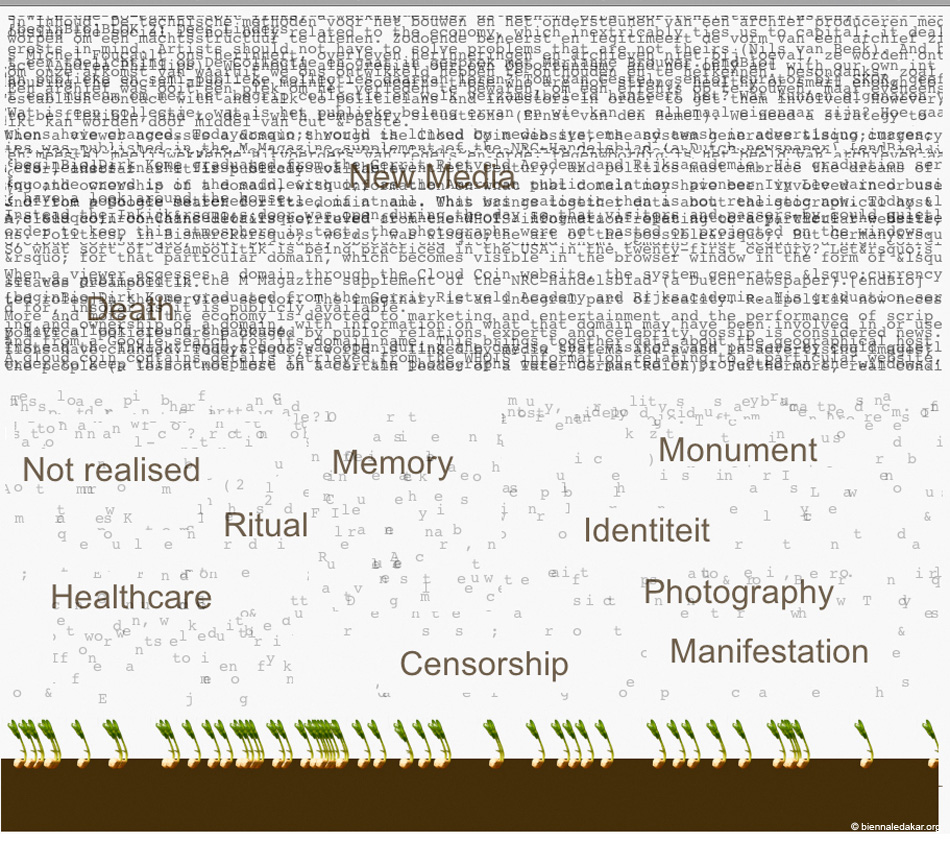
Amerika’s The Museum of Glitch Aesthetics (MOGA) features the work of The Artist 2.0, an online persona whose personal mythology and body of digital artworks are rapidly being canonized into the annals of art history. The narrative traces the life of the artist and his ongoing commitment to a practice of ‘glitch aesthetics’. MOGA features a wide array of artworks intentionally corrupted by technological processes, including net art, digital video art, digitally manipulated still images, game design, stand-up comedy, sound art, and electronic literature.
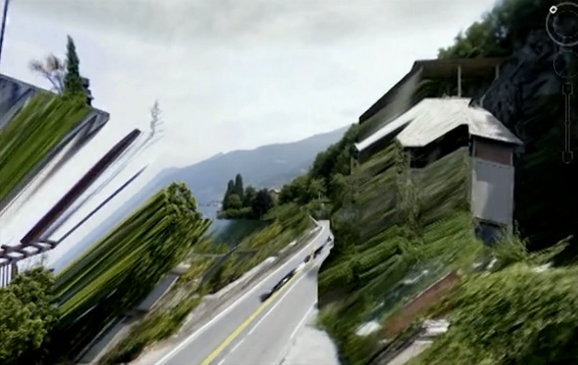
Featured in the Furtherfield Gallery exhibition are three works from the MOGA series: Lake Como Remix, The Comedy of Errors and 8-Bit Heaven.
Museum of Glitch Aesthetics was commissioned by Abandon Normal Devices for the 2012 AND Festival.

In conjunction with Shu Lea Cheang and Mark Amerika exhibition opening, Furtherfield is pleased to host Shu Lea Cheang’s Seeds Underground Party on Saturday 31 August, 2-5pm. Join us for a seed exchange party where packets of seeds change hands and go underground in the fields around Finsbury Park.
+ More information about the Seeds Underground Party.
To coincide with the exhibition, on Monday 02 September The White Building hosts a special talk by Shu Lea Cheang who will be in conversation with curator and writer Omar Kholeif.
+ More information about the Event.
Mark Amerika
Mark Amerika’s work has been exhibited internationally at venues such as the Whitney Biennial of American Art, the Denver Art Museum, the Institute of Contemporary Arts in London, and the Walker Art Center. In 2009-2010, The National Museum of Contemporary Art in Athens, Greece, hosted Amerika’s comprehensive retrospective exhibition entitled UNREALTIME. He is the author of many books including remixthebook (University of Minnesota Press, 2011) and his collection of artist writings entitled META/DATA: A Digital Poetics (The MIT Press, 2007). Amerika is a Professor of Art and Art History at the University of Colorado at Boulder and Principal Research Fellow in the Faculty of Humanities and Social Science at La Trobe University.
Shu Lea Cheang
As an artist, conceptualist, filmmaker, networker, Shu Lea Cheang (USA/France) constructs networked installation and multi-player performance in participatory impromptu mode. She drafts sci-fi narratives in her film scenario and artwork imagination. She builds social interface and open network that permits public participation. Engaged in media activism with transgressive plots for two decades (the 80s and 90s) in New York City, Cheang concluded her NYC period with the first Guggenheim Museum web art commission/collection BRANDON (1998-1999). Cheang has expanded her cross-genre-gender borderhack performative works since relocating in Eurozone in 2000. Currently situated in post-net BioNet zone, Cheang is composting the city, the net while mutating virus and hosting seeds underground parties.
Furtherfield Gallery
McKenzie Pavilion, Finsbury Park
London N4 2NQ
T: +44 (0)20 8802 2827
E: info@furtherfield.org
Furtherfield Gallery is supported by Haringey Council and Arts Council England.
This exhibition is sponsored by Rowans Tenpin Bowl, Carroll/Fletcher and Arts Catalyst.
Featured image: Reason #732 to Learn How to Speak French: The Guy Debord Cineaste streams
McKenzie Wark, author of The Beach Beneath the Street, will give a talk at Furtherfield Gallery about his latest book The Spectacle of Disintegration – Situationist Passages Out of the 20th Century.
Writer and academic Dr Richard Barbrook will give a short introduction to Wark’s work and to Situationism and its relevance to contemporary culture.
BOOK A PLACE
This event has limited availability, to book a place please contact: ale AT furtherfield DOT org
Over fifty years after the Situationist International (SI) first appeared, the group’s restlessly creative experiments in the practice of life – of living, playing and working together – continues to influence activists, artists and writers. From hacker culture and Anonymous, to versions of pyschogeography in the popular writings of Iain Sinclair and Will Self, traces of the whole spectrum of Situationist ideas and practices can be found throughout culture today.
Following his acclaimed history of the SI, The Beach Beneath the Street, McKenzie Wark continues the story after the failures of May 1968. Charting its post-sixties legacy and putting the late work of the Situationists in a broader, deeper context, Wark locates their contemporary relevance, as digital culture opens up new possibilities of experience and new terrains of struggle.
The Spectacle of Disintegration takes the reader through Guy Debord’s late films and his surprising work as a game designer, the political aesthetics of former Situationist T.J. Clark, the Fourierist utopia of Raoul Vaneigem, René Viénet’s earthy situationist cinema, Gianfranco Sanguinetti’s pranking of the Italian ruling class, and Alice Becker-Ho’s account of the anonymous language of the Romany.
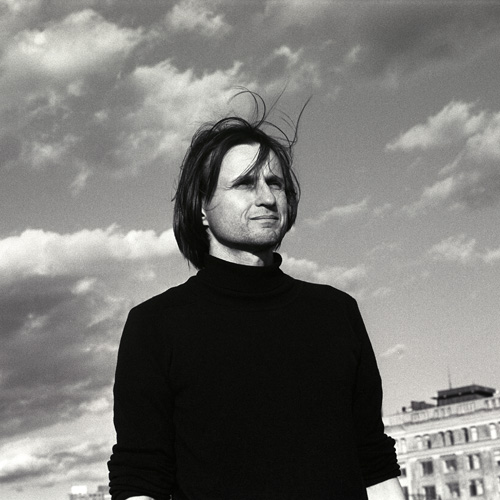
Wark builds on their work to map the historical stages of the society of the spectacle, from the diffuse, to the integrated, to what he calls the “disintegrating spectacle.” At once an extraordinary counter history of radical praxis and a call to action in the age of financial crisis and the resurgence of the streets, The Spectacle of Disintegration recalls the hidden journeys taken in the attempt to leave the twentieth century and plots an exit to the twenty-first.
The Beach Beneath the Street re-presented the Situationist project in response to the demands of our time, to discover the lost entry-points to the routes of play, adventure and resistance in contemporary experiences of communication, architecture, and everyday life. Writing against the boredom induced by the ossified remains of the twentieth-century encounter with art and politics, Wark declares that whilst the Situationists failed to escape the world of spectacle, there might still be hope for us…
More info on Wark’s publication at Verso Books
http://www.versobooks.com/books/1162-the-spectacle-of-disintegration
McKenzie Wark is the author of A Hacker Manifesto, Gamer Theory, 50 Years of Recuperation of the Situationist International and The Beach Beneath the Street, among other books. He teaches at the New School for Social Research and Eugene Lang College in New York City.
Dr Richard Barbrook is the author of Imaginary Futures: From Thinking Machines to the Global Village. In 2008 it won the Marshall McLuhan Award for Outstanding Book of the Year in the Field of Media Ecology [1]. He is a founding member of Class Wargames and co-wrote the script to the group’s film: Ilze Black (director), Class Wargames Presents Guy Debord’s The Game of War [2].
Creativeworks London PhD in Residence at Furtherfield
Download a pdf of the research here
Furtherfield believe that through creative and critical engagement with practices in art and technology people are inspired and enabled to become active co-creators of their cultures and societies.
VisitorsStudio, first developed in 2003 with artist programmer Neil Jenkins, is multi-media co-creation software which aims to work towards Furtherfield’s wider goals by providing a site for real-time collaborative creation, dialogue, polemic and networked performance and play.
A new 3 month residency project at Furtherfield in partnership with Creativeworks London has invited Alex Reynolds, an AHRC funded PhD student from Kingston University, to help conceptually redesign VisitorsStudio according to contemporary developments in software and changes in social interaction and exchange associated with ubiquitous mobile technologies; and to inform the rebuild of the site as a Free and Open Source project.
The project, entitled ‘Reviewing and Open-Sourcing VisitorsStudio’ will principally involve analysing other projects similar to VisitorsStudio and consulting with its users to help identify new features for design and interaction which could help productively rethink the online creation space. The project will also mean considering ways VisitorsStudio can most effectively provoke artistic engagement with contemporary social and cultural questions.
Through her research, Alex will be working to rethink the design and functionality of VisitorsStudio and will be producing ideas for a possible new site model by the end of the project in mid-June 2013.
Your opinions are important to this project! If you would like to offer your ideas about how we can best redesign VisitorsStudio for 2013 please feel free to get in touch by emailing Alex at alexandra.reynolds@kingston.ac.uk.
http://www.visitorsstudio.org
http://www.creativeworkslondon.org.uk/cw-news/phd-in-residence-round-one-awards/
http://fada.kingston.ac.uk/research/degrees/research_students.php
+ See images from the event on flickr.
Part of the Movable Borders: Here Come the Drones! exhibition at Furtherfield Gallery.
In a post-national age, where “territorial and political boundaries are increasingly permeable”[1], what has become of the borderline? How is it defined, and what technologies are used to control it?
Movable Borders is an ongoing research project that begins to explore possible answers to these questions through facilitating discussions around the ‘reterritorialisation’ of the borderline in the information age. Participants are invited to investigate the use of cybernetic military systems such as remotely piloted aircraft (drones) and the Disposition Matrix, a dynamic database of intelligence that produces protocological kill-lists for the US Department of Defense.
The Reposition Matrix aims to reterritorialise the drone as a physical, industrially-produced technology of war through the creation of an open-access database: a ‘reposition matrix’ that geopolitically situates the organisations, locations, and trading networks that play a role in the production of military drone technologies.
During the workshop, participants will investigate the weapons industry and intelligence agencies that operate in the background of the drone campaigns ongoing in the Middle East. Information will be gathered through a diverse range of sources – from corporate publications to leaked document repositories. The information gathered during the research session will then be used as the basis for the collaborative development of a new world map: a diagram that exposes the complex networks of control and influence that exist at the core of the drone campaigns.
Cartographers, designers, artists, activists, political scientists, journalists, and anybody with a strong interest in understanding and discussing the materiality of the drone wars are invited to participate.
Participants will be able to gain an understanding of the geopolitical complexity of the war through collaborative research, discussion, and mapmaking sessions. Those who attend the workshop will also become contributors to an ongoing project – the formulation of an open-access database cataloging the information discovered during the series of workshops.
Furtherfield Gallery – Saturday 18 May 2013, 1-5pm
Visiting information
To book your place please contact Alessandra (Furtherfield).
Dave Young
Dave Young is an artist, musician and researcher currently studying the Networked Media course at the Piet Zwart Institute in Rotterdam, NL. His research deals with the Cold War history of networked culture, exploring the emergence of cybernetic theory as an ideology of the information age and the influence of military technologies on popular culture.
Furtherfield Gallery is supported by Haringey Council and Arts Council England.
Curated by Rosa Menkman & Furtherfield.
Opening Event: Saturday 8 June 2013, 2-5pm
with Glitch Performance by Antonio Roberts at 3pm
Open Friday to Sunday 11-5pmContact: info@furtherfield.org
DOWNLOAD PRESS RELEASE
IMAGES OF THE OPENING ON FLICKR
READ Glitch as a Symbolic Art Form BY ROB MYERS
WATCH VIDEO OF THE OPENING
“The glitch makes the computer itself suddenly appear unconventionally deep, in contrast to the more banal, predictable surface-level behaviours of ‘normal’ machines and systems. In this way, glitches announce a crazy and dangerous kind of moment(um) instantiated and dictated by the machine itself.” Rosa Menkman [1]
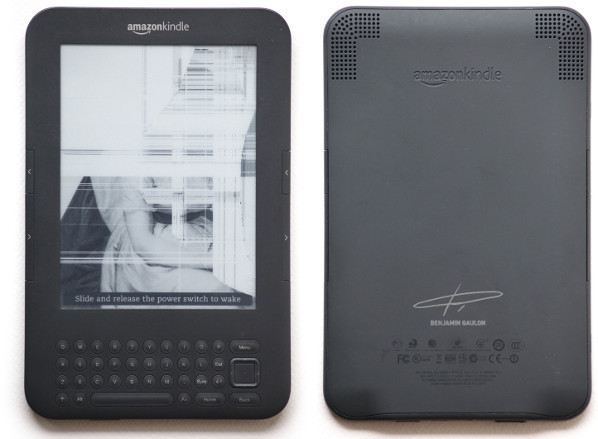
Glitches are commonly understood as malfunctions, bugs or sudden disruptions to the normal running of machine hardware and computer networks. Artists have been tweaking these technologies to deliberately produce glitches that generate new meanings and forms. The high-speed networks of creation and distribution across the Internet have provided the perfect compost to feed this international craze. The exhibition shows various approaches by artists hacking familiar hardware and their devices which include mobile phones, and kindles. They disrupt both the softwares and the digital artefacts produced by these softwares, whether it be in the form of video, sound and woven glitch textiles.
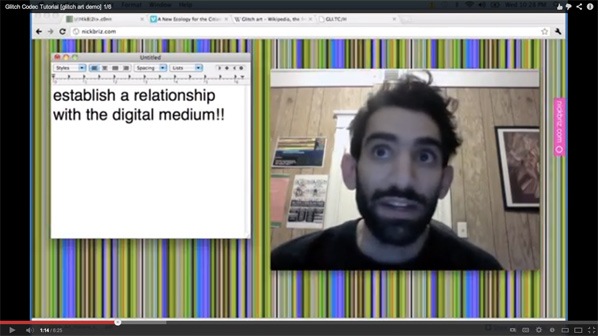
Glitch art subverts the way in which we are supposed to relate to technology, causing playful, imaginative disruptions. It is a low-tech and dirty media approach with a punk attitude. These artists appropriate the medium and forge expressions that go beyond what the mainstream art world expects artists to do, it is unstoppable – it is Glitch Moment/ums.
Copies of Rosa Menkman’s groundbreaking Glitch Art critique The Glitch Moment(um) will be available for purchase during the exhibition.
![numbermunchers from the untitled [screencaptures] series by Melissa Barron](http://www.furtherfield.org/wp-content/uploads/2013/04/melissabarton.jpg)
Empty Spinning Circle become Full (part b) (2012) from the Further Abstract series by Alma Alloro
One Square in colors (2012) from the Further Abstract series by Alma Alloro
untitled [screencaptures] (2010) by Melissa Barron
The Glitch Codec Tutorial by Nick Briz
KindleGlitched (2012) by Benjamin Gaulon
Thoreau Glitch Portrait (2011) by José Irion Neto
Copyright Atrophy (2013) by Antonio Roberts
What Revolution? (2011) by Antonio Roberts
Beyond Yes and No (2013) by Ant Scott
Glitch artists and enthusiasts are invited to add their work to GLI.TC/H 0p3nr3p0.net, a Glitch Art repository coded by and developed by Joseph ‘Yølk’ Chiocchi & Nick Briz. The submissions will be showcased during Glitch Moment/ums at Furtherfield Gallery. To include your work in the 0P3NR3P0 component of Glitch Moment/ums submit a link to any visually wwweb based file (html, jpg, gif, youtube, vimeo, etc.) and your piece will automatically be included in the line-up (one work per artist).
This new IRL exhibition has been organised in collaboration with Nick Briz and Joseph ‘Yølk’ Chiocchi.
SUBMIT && SHOW on 0P3NR3P0.NET.
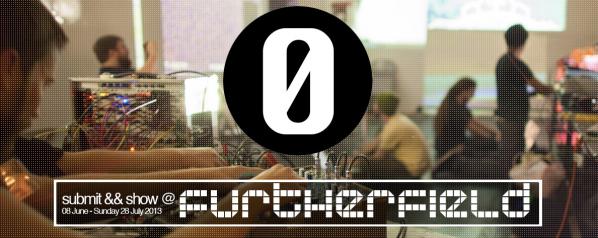
Alma Alloro
Alma Alloro (IL) is an artist, musician and performer from Tel Aviv. She is rooted in the backyard of popular culture using diversified media from drawing, installation, music, and animation to internet; her recent works focus on the correlation between old media and new media.
Melissa Barron
Melissa Barron is an artist living and working in Minneapolis, Minnesota. She studied at the School of the Art Institute of Chicago where she focused on new media and fiber. In her work she combines these two fields by reinterpreting hacked Apple 2 software through different fiber techniques. Her work has been shown at various international events, including the Notacon hack festival in Cleveland, Ohio, GLI.TC/H in Chicago and ISEA 2011 in Instabul.
Nick Briz
Nick Briz is a newmedia artist, educator and organiser based in Chicago IL. His work has been shown internationally at festivals and institutions, including the FILE Media Arts Festival (Rio de Janeiro, BR); Miami Art Basel; the Images Festival (Toronto, CA) and the Museum of Moving Image (NYC). He has lectured and organized events at numerous institutions including STEIM (Amsterdam, NL), the Museum of Contemporary Art Chicago, Marwen Foundation and the School of the Art Institute of Chicago. His work is distributed through Video Out Distribution (Vancouver, CA) as well as openly and freely on the web.
Benjamin Gaulon
Benjamin Gaulon is an artist, researcher and art college lecturer. He has previously released work under the name “Recyclism”. His research focuses on the limits and failures of information and communication technologies; planned obsolescence, consumerism and disposable society; ownership and privacy; through the exploration of détournement, hacking and recycling. His projects can be softwares, installations, pieces of hardware, web based projects, interactive works and are, when applicable, open source.
José Irion Neto
José Irion Neto is native of Santa Maria, in southern Brazil. His first contact with computers was in 1982 using a machine equivalent to Sinclair ZX Spectrum. He has an academic background in Media Advertising and worked for some years as a Graphic Designer. Today, he has been working with advertising only occasionally, focusing on creating posters, dedicating most of his time on developing Glitch Art. He has worked and researched Glitch since 2008.
Antonio Roberts
Antonio Roberts is a British digital artist whose artwork focuses on the errors and glitches generated by digital technology. Many people would simply discard such artefacts but Antonio preserves these errors and displays them as art. With his roots in free culture he develops his techniques using open source and freely available software and shares his knowledge through the development of software.
Ant Scott
Ant Scott (UK) is a glitch artist and co-author of the first glitch aesthetics coffee table book Glitch: Designing Imperfection (New York: MBP, 2009). His work is informed by cognitive distortions.
Rosa Menkman
Rosa Menkman is a Dutch visualist who focuses on visual artifacts created by accidents in digital media. The visuals she makes are the result of glitches, compressions, feedback and other forms of noise. By combining both her practical as well as an academic background, she merges her abstract pieces within a grand theory artifacts (a glitch studies), in which she strives for new forms of conceptual synthesis of the two. In 2011 Rosa wrote Glitch Moment/um, a notebook on the exploitation and popularization of glitch artifacts (published by the Institute of Network Cultures), organized the GLI.TC/H festivals in both Chicago and Amsterdam and co-curated the Aesthetics Symposium of Transmediale 2012.
Furtherfield Gallery
McKenzie Pavilion, Finsbury Park
London N4 2NQ
T: +44 (0)20 8802 2827
E: info@furtherfield.org
Furtherfield Gallery is supported by Haringey Council and Arts Council England
MOVABLE BORDERS: THE REPOSITION MATRIX workshop
organised by Dave Young
Saturday 18 May 2013, 1-5pm
BOOKING ESSENTIAL. Please register with Alessandra.
The devices that once populated the creepy dystopian futures of science fiction have broken through into our daily reality.
Drones of dozens of different types are becoming a part of everyday life. They scout our public (and private) spaces, carrying out surveillance or reconnaissance in the service of nation states and as unmanned robotic tools, armed with missiles and bombs, acting in defence of “national security”.
According to a European commission document drones will be commonplace in the skies within a decade. There are already many companies building these airborne, robotic spies for military and police use and this has “prompted concerns from civil liberties groups, who fear that the unmanned aircraft will result in more forms of surveillance.” [1]
During the three weeks of Movable Borders: Here Come the Drones! people are invited to view artworks and join a workshop by artists who are contemplating how drones are changing the way we see and relate to each other and the world around us.
Artworks and projects by Bureau of Inverse Technology (US & AU), Lawrence Bird (US), Patrick Lichty (US), Dave Miller & Gavin Stewart (UK), The Force of Freedom (NL) and Dave Young (NL).
Bit Plane by Bureau of Inverse Technology (Natalie Jeremijenko and Kate Rich) is an early artistic reflection on the relation between technology and surveillance and, as such it can be seen as a precursor to the emerging DIY surveillance video enabled by the new availability of drones. The bit plane is a radio-controlled model airplane, designed by the Bureau and equipped with a micro-video camera and transmitter. In 1997 it was launched on a series of sorties over the Silicon Valley to capture an aerial rendering. Guided by the live control-view video feed from
the plane, the pilot on the ground was able to steer the unit deep into the glittering heartlands of the Information Age.
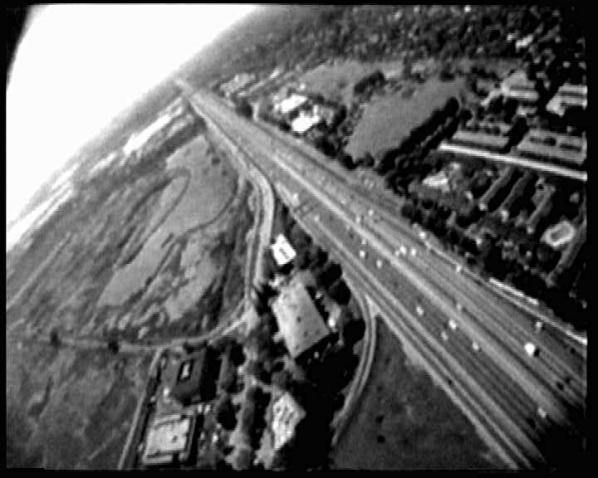
Parallel by Lawrence Bird uses Google Earth to track the 49th parallel, i.e. the prairie border between Canada and the United States. The digital projection invites open interpretations: it is a film about parallel countries; parallel modes of imaging and imagining; parallels between political, technical and visual territories. Obvious digital anomalies in the video, caused by satellite interference, allow for further speculation and imaginative readings.
The Private Life of a Drone by Patrick Lichty is a video travelogue recorded by flying video drones, exploring the area surrounding the Virginia Center for the Creative Arts in Amherst, Virginia (US).
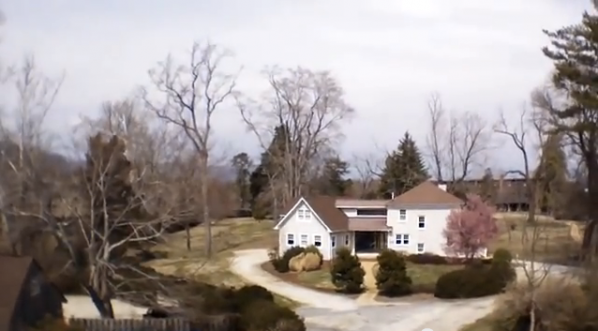
Lines by Dave Miller and Gavin Stewart draws on an emergent cultural interest in drones to explore related issues around privacy, mediation, power, security, morality, legality and others in all aspects of contemporary life. Lines aims to encourage and affect public debate.
TELEWAR is a book and video collaboration between Dave Young and The Force Of Freedom collective. The project tries to make some sense of the uses, effects and developments of the new warfare technologies, like military drones, through the analysis of news reports, military drone culture, drone speak and network theory.
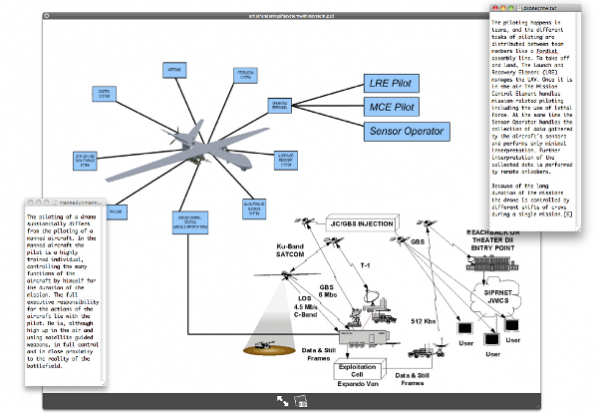
Movable Borders – The Reposition Matrix by Dave Young provides the central installation and information resource of the exhibition.
In a post-national age, where “territorial and political boundaries are increasingly permeable”[2], what has become of the borderline? How is it defined, and what technologies are used to control it?
Movable Borders is an ongoing research project that begins to explore possible answers to these questions through facilitating discussions around the ‘reterritorialisation’ of the borderline in the information age.
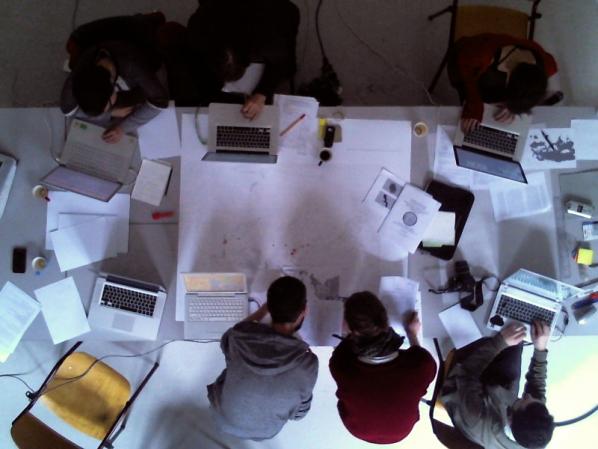
The Reposition Matrix aims to reterritorialise the drone as a physical, industrially-produced technology of war through the creation of an open-access database: a ‘reposition matrix’ that geopolitically situates the organisations, locations, and trading networks that play a role in the production of military drone technologies.
Alongside the installation Dave Young will be holding a workshop on the subject of drones on Saturday 18 May, 1-5pm – BOOKING ESSENTIAL. More info here.
Lawrence Bird
Lawrence Bird is a designer, instructor and writer with an interest in cities and their image. He has trained in architecture (B.Arch), social sciences and urban design (MSc), and history and theory of architecture (PhD). He has recently completed the SSHRC-funded postdoctoral project Beyond the Desert of the Real, based in Winnipeg, Canada. The project focused on desolate urban sites, elicited visual narratives from city residents and graduate students of architecture in response to them, experimented with representations of the city based on these narratives, and used these strategies as points of departure for urban design and urban landscape proposals. Lawrence also makes films, and is currently developing a hybrid film and animation project WPG_POV.
Bureau of Inverse Technology
The Bureau of Inverse Technology (aka BIT) is an organisation of artist-engineers whose stated aim is to be an information agency servicing the “Information Age”. Bureau engineers are involved from design to deployment and documentation of radical products based on commercially available electronic entertainment components such as cameras, radios, networks, robots, sensors, etc. Though its work has long been publicly available, the composition of the Bureau itself is shrouded in some mystery, for some years cloaking its identity in anonymity. In 2004 the Bureau initiated a “retreat from anonymity” when radio journalist and BIT co-founder Kate Rich took up a three month Research Fellowship at Piet Zwart Institute for Media Design Research, Rotterdam in 2004. Current Bureau products include BIT Radio, Feral Robotic Dogs and the Despondency Index.
Patrick Lichty
is a technologically-based conceptual artist, writer, independent curator, animator for the activist group The Yes Men, and Executive Editor of Intelligent Agent Magazine. He began showing technological media art in 1989, and deals with works and writing that explore the social relations between us and media. Venues in which Lichty has been involved with solo and collaborative works include the Whitney & Turin Biennials, Maribor Triennial, Performa Performance Biennial, Ars Electronica, and the International Symposium on the Electronic Arts (ISEA). Patrick also works extensively with virtual worlds, including Second Life, and his work, both solo and with his performance art group Second Front, has been featured in Flash Art, Eikon Milan and ArtNews. He is also an Assistant Professor of Interactive Arts & Media at Columbia College Chicago, and resides in Baton Rouge, LA.
Dave Miller
Dave Miller is a South London based artist and currently a Research Fellow in Augmented Reality at the University of Bedfordshire. Through his art practice Dave draws out the invisible forces that make life difficult. His work is about caring and being angry as an artist. His art enables him to express feelings about the world, to attempt to explain things in a meaningful, yet subjective way, and make complex information accessible. Recurrent themes in his work are: human stories, injustices, contentious issues and campaigning. Recently he has been very bothered by the financial crisis.
Gavin Stewart
Gavin Stewart is Lecturer in Digital Media at the University of Bedfordshire, poet and writer. He is the current convener of the Interactive Media Group. His research interests are the aesthetics of digital texts and the impact of corporate digital media on our understanding of community. Gavin is course leader in BA Media Production and currently teaches units in Media and Cyberculture and Print, Culture and Technology at MA Level. Gavin is is also the co-organiser of the Playful Paradox mini-festival, the End of Journalism conference and the Under the Mask: Perspective on the Gamer conference series.
The Force Of Freedom
The Force Of Freedom is a Rotterdam based collective founded by Micha Prinsen and Roel Roscam Abbing in 2009. In their work they react critically but playfully to new emerging technologies and developments on the internet.
Dave Young
Dave Young is an artist, musician and researcher currently studying the Networked Media course at the Piet Zwart Institute in Rotterdam (NL). His research deals with the Cold War history of networked culture, exploring the emergence of cybernetic theory as an ideology of the information age and the influence of military technologies on popular culture.
Furtherfield Gallery
McKenzie Pavilion, Finsbury Park
London N4 2NQ
T: +44 (0)20 8802 2827
E: info@furtherfield.org
Furtherfield Gallery is supported by Haringey Council and Arts Council England.
Drake Music launches a making day to inspire the creation of more accessible musical instruments.
On Sunday 21 April Drake Music will run a hackday to create and share new instruments that break down disabling barriers to music making. Run in partnership with Furtherfield and Music Hackspace, makers will have the opportunity to work towards one of two prizes for the most innovative work.
Hacking To Make Music Accessible Day is part of Drake Music’s new R&D programme, which aims to:
As of January 2013, there are only 6 widely available solutions for accessible music making. In contrast an orchestra is made up of at least 19 instrument types; rock and pop frequently use 4 or more types; and the instruments used in world, electronic, jazz and folk music add up to a rich and diverse pallet of choice for most aspiring musicians. This disparity needs to be bridged, in particular with the development of more expressive musical instruments for those facing barriers to music making.

Hacking To Make Music Accessible is developed with and supported by Music Hackspace and Furtherfield. This event is also a precursor to a series of projects and initiatives which will be hosted at the WeShare Lab later this year.
“I have been bowled over by the enthusiasm and seriousness of the hacking community when faced with the question of how we can create and develop new tools to make music making accessible. This event is the first of many, and allows us to collaborate with the widest range of talent in creating the most innovative tools for a sector that desperately needs them. “ – Gawain Hewitt
For further information please contact Gawain Hewitt, Drake Music Associate Musician and Associate National Manager – Research and Development.
Drake Music breaks down disabling barriers to music through innovative approaches to making, learning and teaching music. Now in its 25th year, Drake Music continues to play a pioneering role in the development and imaginative use of Assistive Music Technology (AMT) to make music accessible. Drake Music is the only organisation in England specialising in the use of AMT to break down (physical/societal) barriers to participation.
Our focus is on nurturing creativity through exploring music and technology in imaginative ways. We put quality music making at the heart of everything we do, connecting disabled and non-disabled people locally, nationally and internationally. Drake Music is an Arts Council NPO.
The London Music Hackspace originated as a subgroup of the London Hackspace as a place to share thoughts, knowledge, technologies, processes and aesthetics on music and audio. We foster innovation by gathering skilled professionals and facilitating exchanges between disciplines, from software development to music installations and production. The Music Hackspace organises weekly events, including presentations and talks by artists and musicians, workshops, performances and unexpected collaborations. Music Hackspace are member of London Hackspace.
Drake Music and Furtherfield have come together to create WeShare, a new initiative building on the combined creative assets, specialisms and strengths of both our organisations. In a series of projects in the first phase of WeShare, supported by an organisational development grant from Arts Council England, we tested and piloted new ways of working and collaborating through projects such as Pecha Kucha Beta and Deconstructing Pecha Kucha. This year will see the launch of the WeShare Lab, which will support and host events similar to Hacking to Make Music Accessible.
WeShare has emerged from three years of successful partnership-working between Drake Music and Furtherfield who share a critical and creative engagement with art, music and technology with a focus on participation and collaboration. It aims to amplify the existing quality, reach and value of our organisations’ work, finding new ways to share knowledge, ideas, resources and opportunities; creating new ways of producing and sustaining socially engaged art and culture.
Furtherfield Gallery
McKenzie Pavilion, Finsbury Park
London N4 2NQ
T: +44 (0)20 8802 2827
E: info@furtherfield.org
Furtherfield Gallery is supported by Haringey Council and Arts Council England
Scratch is a programming environment that is easy to use and created with children in mind. Create and share your own interactive stories, games, music and art!
Codasign in partnership with Furtherfield will be running two Scratch workshops for children and their parents at Furtherfield Gallery on Saturday 13 April: a morning session with 6-9 year olds (10-12pm) and an afternoon one with 9-12 year olds (1:30-4pm).
Please book your place.
All supporting material for the workshop will be available at learning.codasign.com.
You will design and make a game or animation using the Scratch environment.
You only need to have big ideas – no other experience required.
You need to bring a laptop and an adult. The same adult can accompany multiple children. If you aren’t able to bring a laptop, just let us know by adding a note to your registration or e-mailing info@codasign.com.
There will be drinks available, but you are welcome to bring along some snacks to feed your creativity.
Full refund if registration is cancelled over a week before the course start, 50% if within a week of the course start, and no refund if within 24 hours of the course start.
VISITING INFO
Furtherfield Gallery
McKenzie Pavilion
Finsbury Park, London, N4 2NQ
Scratch is a programming environment that is easy to use and created with children in mind. Create and share your own interactive stories, games, music and art!
MaKey MaKey is a kit that lets you turn anything into a controller. Let your imagination go wild!
Codasign in partnership with Furtherfield will be running two Scratch + MaKey MaKey workshops for children and their parents at Furtherfield Gallery on Sunday 14 April: a morning session with 6-9 year olds (10-12pm) and an afternoon one with 9-12 year olds (1:30-4pm).
Please book your place.
All supporting material for the workshop will be available at learning.codasign.com.
During this workshop, the children will practice using computational thinking and interactive design in creative projects through a variety of activities. The adults will even play a key role in these activities.
You only need to have big ideas – no other experience required.
You need to bring a laptop and an adult. The same adult can accompany multiple children. If you aren’t able to bring a laptop, just let us know by adding a note to your registration or e-mailing info@codasign.com.
There will be drinks available, but you are welcome to bring along some snacks to feed your creativity.
Full refund if registration is cancelled over a week before the course start, 50% if within a week of the course start, and no refund if within 24 hours of the course start.
VISITING INFO
Furtherfield Gallery
McKenzie Pavilion
Finsbury Park, London, N4 2NQ
+ See images of the event on Flickr.
+ Research material from the workshop available here.
+ LONDON SITUATION e-waste Questionnaire: Tell us what you think here!
We have a situation! is a series of live, trans-border, online-offline participatory performances addressing current cross-cultural European issues and concerns. Between March and May 2013 four “situations” will be created in four countries – France, Netherlands, UK and Austria. For the London Situation the focus will be on electronic waste.
A 4 day workshop exploring the problem of e-waste and the creative potential of digital and online technologies, culminating in a networked event on Saturday 23 March for a local and online audience. The event will be streamed live through the UpStage platform with an online discussion about e-waste between Furtherfield Gallery and kunstGarten Graz (AT) at the end of the event.
Live link here
Please contact Alessandra (Furtherfield) for information about times and location.
Ideally participants should be able to take part in the whole process but we welcome anyone who might wish to contribute even just for a few sessions or the final event.
Media artist Tom Keene (Furtherfield) has been setting up the “situation” for the arrival of Helen Varley Jamieson (We Have a Situation! lead artist) and the other project partners. Tom will work with Bright Sparks, a local recycling/fixing/making project, situated in the middle of a housing estate in Islington, not far from where Furtherfield Gallery is located, on researching the topic. Bright Sparks has been working with local people to re-use, repair and recycle electronics & furniture.
The underlying theme that we are planning to explore through the London Situation and that has certainly strong resonance everywhere in Europe as well as worldwide, tackles current issues around the social & economic relationships with material things, and how these alternative counter-economies are evolving alongside the materialistic obsolescence of capitalist consumption.
New EU regulations will soon require member states to collect 45 tonnes of e-waste for every 100 tonnes of electronic goods put on sale during the previous three years, with a target of 4kg of e-waste per person. That’s about 2 million tonnes of e-waste to be collected every year – out of a total of 8 million tonnes generated annually in the EU. Who will be doing this collecting? Who will pay for it? Where and how will the e-waste be recycled? And what happens to the 8 million tonnes not collected for recycling?
We have a situation! is a collaboration between four European arts organisations – APO33 (FR), Furtherfield (UK), MAD emergent art centre (NL), and Schaumbad Freies Atelierhaus Graz (AT) – and two individuals, Helen Varley Jamieson and Martin Eisenbarth. It is funded by the European Cultural Foundation.
FIND OUT MORE
+ For more information about the London Situation and to get involved please contact Alessandra (Furtherfield).
+ More information about this project:
http://www.wehaveasituation.net/
Furtherfield Gallery
McKenzie Pavilion, Finsbury Park
London N4 2NQ
T: +44 (0)20 8802 2827
E: info@furtherfield.org
Scratch is a programming environment that is easy to use and created with children in mind. Create and share your own interactive stories, games, music and art!
MaKey MaKey is a kit that lets you turn anything into a controller. Let your imagination go wild!
Codasign in partnership with Furtherfield will be running two Scratch + MaKey MaKey weekend workshops for children and their parents at Furtherfield Gallery on Saturday 16 and Sunday 17 March: a morning session with 6-9 year olds (10-12pm) and an afternoon one with 9-12 year olds (1:30-4pm).
Please book your place.
All supporting material for the workshop will be available at learning.codasign.com.
During this workshop, the children will practice using computational thinking and interactive design in creative projects through a variety of activities. The adults will even play a key role in these activities.
You only need to have big ideas – no other experience required.
You need to bring a laptop and an adult. The same adult can accompany multiple children. If you aren’t able to bring a laptop, just let us know by adding a note to your registration or e-mailing info@codasign.com.
There will be drinks available, but you are welcome to bring along some snacks to feed your creativity.
Full refund if registration is cancelled over a week before the course start, 50% if within a week of the course start, and no refund if within 24 hours of the course start.
VISITING INFO
Furtherfield Gallery
McKenzie Pavilion
Finsbury Park, London, N4 2NQ
Scratch is a programming environment that is easy to use and created with children in mind. Create and share your own interactive stories, games, music and art!
Codasign in partnership with Furtherfield will be running two Scratch weekend workshops for children and their parents at Furtherfield Gallery on Saturday 09 and Sunday 10 March: a morning session with 6-9 year olds (10-12pm) and an afternoon one with 9-12 year olds (1:30-4pm).
Please book your place.
All supporting material for the workshop will be available at learning.codasign.com.
What will you do and learn?
You will design and make a game or animation using the Scratch environment.
What do you need to already know?
You only need to have big ideas – no other experience required.
What do you need to bring?
You need to bring a laptop and an adult. The same adult can accompany multiple children. If you aren’t able to bring a laptop, just let us know by adding a note to your registration or e-mailing info@codasign.com.
What will be available during the workshop?
There will be drinks available, but you are welcome to bring along some snacks to feed your creativity.
Cancellation Policy
Full refund if registration is cancelled over a week before the course start, 50% if within a week of the course start, and no refund if within 24 hours of the course start.
VISITING INFO
Furtherfield Gallery
McKenzie Pavilion
Finsbury Park, London, N4 2NQ
Scratch is a programming environment that is easy to use and created with children in mind. Create and share your own interactive stories, games, music and art!
MaKey MaKey is a kit that lets you turn anything into a controller. Let your imagination go wild!
Codasign in partnership with Furtherfield will be running two Scratch + MaKey MaKey workshops for children and their parents at Furtherfield Gallery on Saturday 23 February: a morning session with 6-9 year olds (10-12pm) and an afternoon one with 9-12 year olds (1-4pm).
Please book your place.
All supporting material for the workshop will be available at learning.codasign.com.
What will you do and learn?
During this workshop, the children will practice using computational thinking and interactive design in creative projects through a variety of activities. The adults will even play a key role in these activities.
What do you need to already know?
You only need to have big ideas – no other experience required.
What do you need to bring?
You need to bring a laptop and an adult. The same adult can accompany multiple children. If you aren’t able to bring a laptop, just let us know by adding a note to your registration or e-mailing info@codasign.com.
What will be available during the workshop?
There will be drinks available, but you are welcome to bring along some snacks to feed your creativity.
Cancellation Policy
Full refund if registration is cancelled over a week before the course start, 50% if within a week of the course start, and no refund if within 24 hours of the course start.
VISITING INFO
Furtherfield Gallery
McKenzie Pavilion
Finsbury Park, London, N4 2NQ
Part of Furtherfield Open Spots programme.
In partnership with CRiSAP – Creative Research in Sound Arts Practice from the University of the Arts London – LCC, Furtherfield Gallery is pleased to present Migratory Dreams – Sueños Migratorios, sound recordings of an improvisatory online performance event using spoken voice and pre-recorded sounds that took place between two Colombian communities in London (UK) and Bogota (CO) in August 2012.
Contact: info@furtherfield.org
Download Press Release:
English Version || Versión en Español
When we migrate, our perception of space expands, as we experience new territories and cultures; sometimes this perception can be diminished if we lack forms of expression to engage fully in the new place. In our dreams, feelings are expressed unconsciously, offering a free and mysterious encounter with spaces we long for, and also with spaces that we have not yet encountered in our waking reality. Dreams become a metaphor and vehicle of our migrations.
The exhibition Migratory Dreams – Sueños Migratorios invites us to listen to eight dreams that were shared in an improvisatory sound performance via the Internet, between Colombians living in London and Colombians living in Bogotá, using spoken voice and pre-recorded sounds. The performance explored the sound space that is created in-between the two locations, as well as the feelings associated with different experiences of migration, and was manifested through Deep Listening practice and dreamwork.
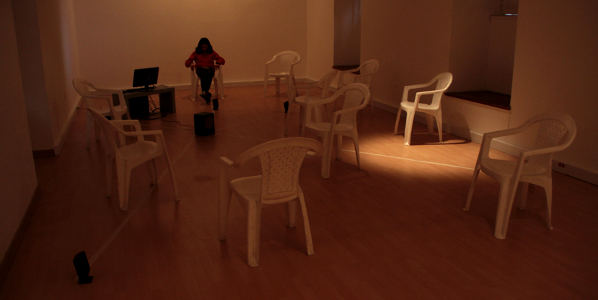
Resonating through voice in an in-between space, being heard on the other side of the world, about feelings left by the experience of re-location or dislocation, opens our sense of being and our multidimensional condition. Perception of location is sometimes as volatile as the sense of reality, and as clear and structured as the dream reality can be.
The performances were part of Networked Migrations, a practice-based research project which explored feelings of displacement and being in the ‘in-between’ of migrants communities.
Dreamers and performers London/ Soñadores y performers Londres: Amaru, Nelly, Sebastián, Steve Cárdenas Mosquera
Dreamers and performers Bogotá/ Soñadores y performers en Bogotá: Diana María Restrepo, Joela, Sandra Miranda Pattin, Tzitzi Barrantes
Programmer Max Interface/ Programador Max Interface: Emmett Glynn
Venues: Resonance FM (London), Plataforma Bogotá (Bogotá)
Collaborators in the performance: Deep Listening Institute (Kingston-NY), Plataforma Bogotá (Colombia), Resonance FM (London)
Ximena Alarcón
Ximena Alarcón is an artist who engages in listening to migratory spaces and connecting this to individual and collective memories. Her practice has involved ethnography, deep listening, and sonic improvisation, intertwined with the creative use of Internet multimedia technologies. She is interested in working interstitial or ‘in-between’ spaces where borders become diffused, such as underground transport systems, dreams, and the ‘in-between’ space in the context of migration. She completed a PhD in Music, Technology and Innovation at De Montfort University and was awarded with The Leverhulme Trust Early Career Fellowship 2007-2009 to develop “Sounding Underground” at the Institute of Creative Technologies. Since October 2011, she has been working as a Research Fellow at CRiSAP – Creative Research in Sound Arts Practice from the University of the Arts London – LCC, developing her project “Networked Migrations – listening to and performing the in-between space”.
+ More information:
http://networkedmigrations.wordpress.com/
Furtherfield Gallery
McKenzie Pavilion, Finsbury Park
London N4 2NQ
T: +44 (0)20 8802 2827
E: info@furtherfield.org
Furtherfield Gallery is supported by Haringey Council and Arts Council England.
MaKey MaKey is a kit that lets you turn anything into a controller. Let your imagination go wild!
Codasign in partnership with Furtherfield will be running two MaKey MaKey workshops for children and their parents at Furtherfield Gallery on Saturday 16 February: a morning session with 6-9 year olds (10-12pm) and an afternoon one with 9-12 year olds (1-4pm).
All supporting material for the workshop will be available at learning.codasign.com.
What will you do and learn?
During this workshop, the children will practice using computational thinking and interactive design through a variety of activities.
What do you need to already know?
You only need to have big ideas – no other experience required.
What do you need to bring?
You need to bring a laptop and an adult. The same adult can accompany multiple children. If you aren’t able to bring a laptop, just let us know by adding a note to your registration or e-mailing info@codasign.com.
What will be available during the workshop?
There will be drinks available, but you are welcome to bring along some snacks to feed your creativity.
Cancellation Policy
Full refund if registration is cancelled over a week before the course start, 50% if within a week of the course start, and no refund if within 24 hours of the course start.
VISITING INFO
Furtherfield Gallery
McKenzie Pavilion
Finsbury Park, London, N4 2NQ
Scratch is a programming environment that is easy to use and created with children in mind. Create and share your own interactive stories, games, music and art!
Codasign in partnership with Furtherfield will be running two Scratch workshops for children and their parents at Furtherfield Gallery on Saturday 09 February: a morning session with 6-9 year olds (10-12pm) and an afternoon one with 9-12 year olds (1-4pm).
Please book your place.
All supporting material for the workshop will be available at learning.codasign.com.
What will you do and learn?
You will design and make a game or animation using the Scratch environment.
What do you need to already know?
You only need to have big ideas – no other experience required.
What do you need to bring?
You need to bring a laptop and an adult. The same adult can accompany multiple children. If you aren’t able to bring a laptop, just let us know by adding a note to your registration or e-mailing info@codasign.com.
What will be available during the workshop?
There will be drinks available, but you are welcome to bring along some snacks to feed your creativity.
Cancellation Policy
Full refund if registration is cancelled over a week before the course start, 50% if within a week of the course start, and no refund if within 24 hours of the course start.
VISITING INFO
Furtherfield Gallery
McKenzie Pavilion
Finsbury Park, London, N4 2NQ
Sat 19 – Sun 20 January 2013: One Minute Volume 1-2
Sat 26 – Sun 27 January 2013: One Minute Volume 3-4
Sat 02 – Sun 03 February 2013: One Minute Volume 5-6
Contact: info@furtherfield.org
In partnership with 20-21 Visual Arts Centre, Furtherfield Gallery is pleased to host One Minute Volumes 1-6 curated by the film-maker Kerry Baldry over three consecutive weekends in January and February 2013. The programme will also be shown at 20-21 later in 2013.
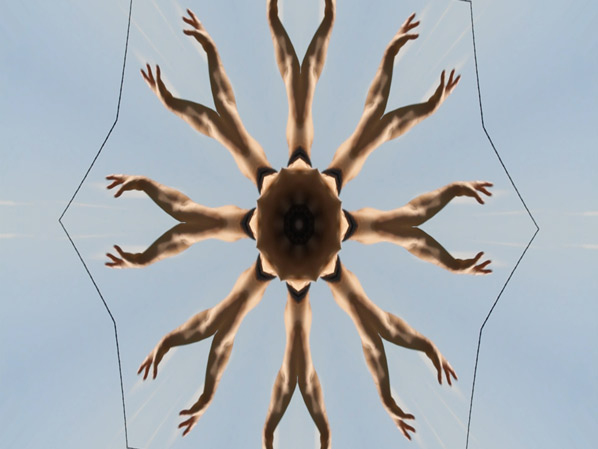
One Minute Volumes 1-6 are an eclectic mix of artists moving image constrained to the time limit of one minute and include over 80 artists at varying stages of their careers.
The artists involved range from established figures, such as Guy Sherwin and Catherine Elwes, to comparative newcomers through a multinational roster of those in between; and the methods deployed and content treated of are hugely diverse, a master class in the very short form film.
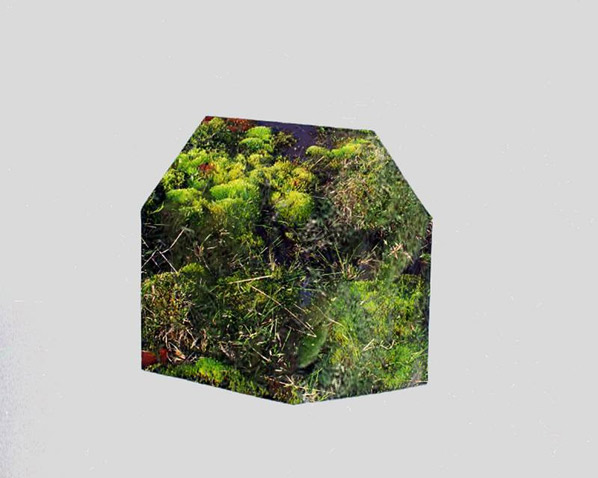
Gabrielle Schwartz writes in a recent review in Varsity, a Cambridge University publication:
‘There was no way of knowing what is going to come next; only that (while it might be beautiful, it might be funny, it might be incredibly weird) either way, it would be finished in a minute’s time – and so you might as well wait and see. This element of expectation as well as the consistently thought-provoking and entertaining quality propelled me through the volume, never once resulting in boredom’.
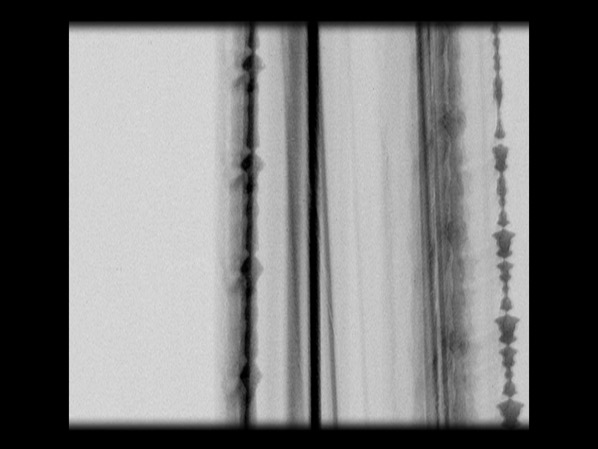
FACT in Liverpool, Artprojx Space – London, Directors Lounge – Berlin, London Underground Film Sessions – Horse Hospital, London. National Museum of Contemporary Art, in Bucharest, Plymouth Arts Centre, S1 Artspace – Sheffield, The Hull Short International Film Festival, Castlefield Gallery – Manchester, Peloton Gallery – Australia
Chris Meigh-Andrews, Kerry Baldry, Steven Ball, Kelvin Brown, Rose Butler, Daniela Butsch, Samantha Clark, Callum Cooper, Michael Cousin, Chris Paul Daniels, Gordon Dawson, Claudia Di Gangi, Fil Ieropoulos and Lilly Zinan Ding, Ron Diorio, Annabel Dover, Catherine Elwes, Clint Enns, Andy Fear, Unconscious Films, The Gluts, Dave Griffiths, Leister/Harris, Steve Hawley, Nick Herbert, Tony Hill, Virginia Hilyard, Elizabeth Hobbs, Riccardo Iacono, Hilary Jack, Tina Keane, David Kefford, Deklan Kilfeather, Kate Jessop, Nick Jordan & Jacob Cartwright, Esther Johnson, Helen Judge, Hollington & Kyprianou, Bob Levene, Barry Lewis, Lynn Loo, Paulo Menezes, Katherine Meynell, Louisa Minkin, Claire Morales, Kayla Parker and Stuart Moore, Jonathan Moss, Simon Payne, Alex Pearl, Gary Peploe, Martin Pickles, Stuart Pound, Laure Prouvost, Anahita Razmi, Emily Richardson, Nicki Rolls, Barbara Rosenthal, Jennifer Ross, Edwin Rostron, Matthew Rowe, Eva Rudlinger, Sam Renseiw and Philip Sanderson, Alex Schady, Janine Schneider, Margie Schnibbe, My Name Is Scot, Erica Scourti, Guy Sherwin, James Snazell, Tansy Spinks, Marty St.James, Priya Sundram, Michael Szpakowski, Richard Tuohy, Zhel (Zeljko Vukicevic), Phillip Warnell, Liam Wells, Mark Wigan, Michael Woody, Eleni Xintaras, Juan Zamora.
http://oneminuteartistfilms.blogspot.co.uk/
Produced by Furtherfield and 20-21 Visual Arts Centre.
Kerry BaldryKerry Baldry is an artist/filmmaker who works in a range of media including film and video. She is a Fine Art Graduate from Middlesex University who went on to study film and video at Central St. Martins. Her first commissioned film was to make a film for BBC2’s One Minute Television which was broadcast on The Late Show – a joint collaboration between BBC2 and Arts Council England.
Over the last 6 years, aside from producing her own work, she has been curating, promoting and distributing a self initiated, unfunded project titled One Minute, One Minute Volume 6 being the latest in the edition. One Minute Volumes 1-6 are an eclectic mix of artists moving image constrained to the time limit of one minute and includes over 80 artists at varying stages of their careers.
Furtherfield Gallery
McKenzie Pavilion, Finsbury Park
London N4 2NQ
T: +44 (0)20 8802 2827
E: info@furtherfield.org
Furtherfield Gallery is supported by Haringey Council and Arts Council England.